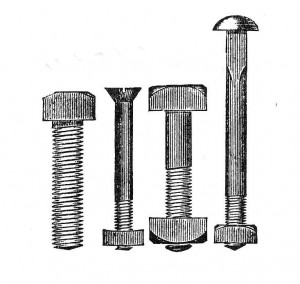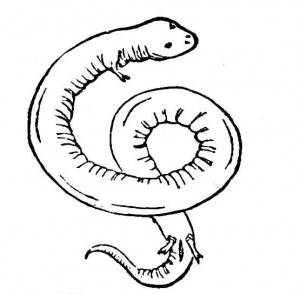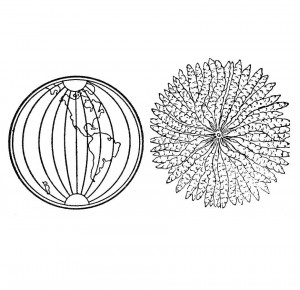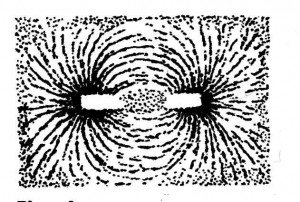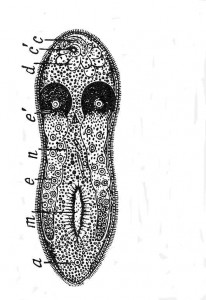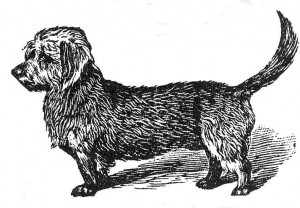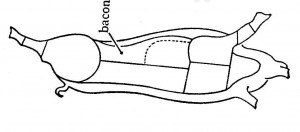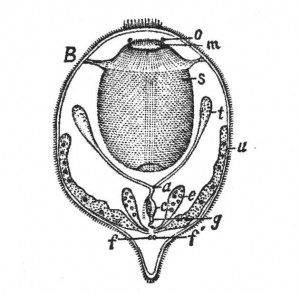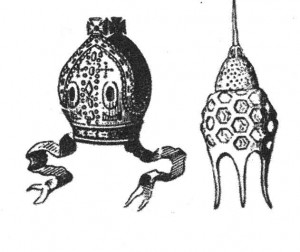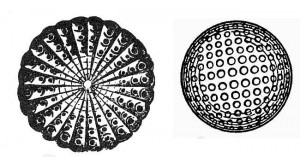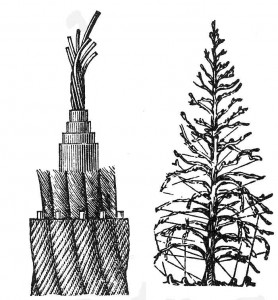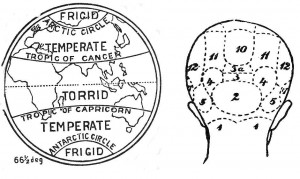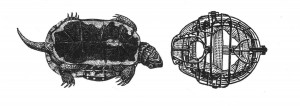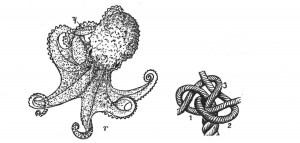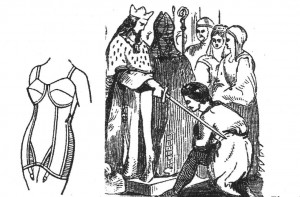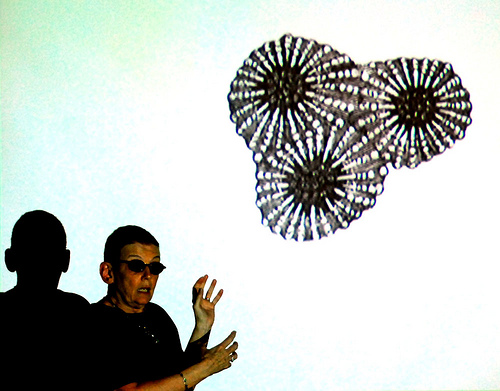The Natural & Manufactured Public Lecture and Essay
GERARD CURTIS
Whatever Happened to Landscape Art:
From Environmental Art to Bio-Genetic Bunnies and Bio-terrorism
This is a rough draft text taken from a talk delivered at the ODD Gallery in Dawson City, Yukon, on August 12th of 2005 for the exhibition “The Natural/The Manufactured”, featuring Peter von Tiesenhausen and Shirley Wiebe. As such it serves as a transcript of point-form jot notes and ideas cobbled together before the talk (actually two days of stream of conscience writing), though it lacks the ad-lib additions and visual narrative of slides that originally accompanied it (or the dramatic pen red-line slash throughs, made an hour or so before the talk, that cut it down to a 2 hours). Many of the images and notions were intended as starting points for ideas to be discussed, and the majority of the material here was cut during the process of the talk itself. What follows then is a post-talk blog, a polemic with broad historical strokes and wild generalities, and a transcript of the jot notes put together for the August 12th talk – yet within this mash (which can exist as that original stream in the vast server capacity of cyber-space) there exists, I think, some worthwhile points…..
Prologue: “Super Natural British Columbia”
In a state of indolence brought about by an aptly named performance project called “The Indolence Project” (to counter the idea of artistic labour of a performance project called “The Sisyphus Project” I had been engaged with in Dawson City), I’m presently writing this prologue by English Bay in Vancouver – having escaped, as many locals do, the natural winter wilds/wiles of Dawson City for a warmer clime. The “latté” culture of the West End of Vancouver revolves around one of the highest population densities in all of Canada. Row after row of townhouses, condos (some still leaking after they were constructed to distorted California building codes) and high-rises — all concrete and veneer manufacturing — set against one of the most spectacular natural backdrops in the world. Stanley Park is the area’s ecological lungs — a highly planned reminder of what once was natural (indeed Vancouver has been repeatedly named in the top ten, and often the top, of the best cities in the world to live due to these confluences of the natural and the manufactured; the perfect safe, yet wild, mountain back-dropped playground – a New World echo of the manufactured naturalness of Geneva which perennially is first or second in the world city rankings as well).
The provincial moniker of “Super Natural British Columbia seemed appropriate to these reflective considerations on the natural and the manufactured talk I gave in Dawson, for like Vancouver’s West End, British Columbia’s naturalness has been highly manufactured as a tourist lure. Its nearby destinations, like the world-class Whistler ski resort, Long Beach and Pacific Rim, and the mountain back-dropped wineries of the interior, stand in the foreground, with the original manufacturing history hidden behind this façade. In contrast the Yukon’s naturalness (where this paper was originally developed), and particularly Dawson City’s naturalness, is all highly-featured manufacturing (mining development, land appropriation) as a façade in a way to the natural — though eco-tourism is gradually changing this to the Vancouver inverse.
The valley leading into Dawson City is covered in kilometre-long entric tailing piles, residual mining traces, creating a spectacular devastated setting and one of the world’s largest industrial waste/brown sites – in a dumping process that is ongoing since the 1910s and 20s. Yet these traces are now a growing tourist attraction as a “brown-scape” heritage, a Disneyfied industrial wasteland, becoming more so its own mythological features and ongoing heritage resource in the process (for dumping still effectively goes on with placer mining). The enteric piles seem natural here, even if humanly manufactured, lacking in any contrast to the natural – but yet oddly natural. The tailing piles seem part of the land’s mythos, the natural outgrowth of the Gold Rush and gold’s almost genetic imprint on us – they are part and parcel of the landscape of the environment and the body. In fact Peter von Tiesenhausen, as part of his exhibition here, has shown the similarity of the aptly-titled miner worms (insects who tunnel patterns with their systematic devouring of the veins of leaves) to the miners who devoured the land here, with exactly the same patterning by both when the land is seen from the air. This is thus a strikingly surreal landscape where animal infestations echo humankind’s infestations – and in turn both echo intestinal twistsing and digestion — with Gold Rush industrialism and manufacturing being the “historical” natural that leads into the land itself and then worms itself back to the biological.
Vancouver exists then in an artificial contrast to the beautiful industrial wasteland of Dawson; yet it is just as relevant in its manufactured/natural patterning. The docklands here in Vancouver — which once gave it a similar manufacturing appeal — being swallowed up by condo developments with priceless views, and new planned maritime museum/ holiday ventures, mining into old dockland building yards for a maritime playground, turning wasteland into brown-scape chic. Even the superstructures of the housing here are not that dissimilar to the superstructures of the ships that once docked near these lands. In fact many tower complexes in Vancouver sport structural prows, aimed towards the water front, slicing the ocean air with retro-streamlining. In Vancouver all of this has, in effect, has Disneyfied the natural into the super/sur-natural. There are even giant, purposely placed, sculptures of ship ribs rusting on the beaches of English Bay to give the sense of a shipwrecked, wild coast still in its exploration stage, while drift logs are hauled into place on the cleaned sand of the endlessly tractor combed beaches for that perfect setting. In the Yukon blasted wasteland and the bruised greenness reclaims our stake on the natural and regresses us back to our basic desire to batter away at the dichotomy which other forces (tourism, monetary, aesthetic) cannibalized and artificially collapse.
Prologue # 1
The natural tendency to indolence that I’m in at the moment, which lends itself to ideas but not to writing essays and talks (an indolence not to be confused with things like the “slow” movement in food, education, and culture, that are, in reality, very labour intensive), has also led me to write part of this essay while surfing off the coast of Pacific Rim Park. Events here at Chesterman Beach, since my departure from Dawson, have transpired to give me a slightly new perspective on the talk I gave on “The Natural/The Manufactured” at Dawson a few weeks back.
Only a short distance away from where I am now, rumour has it the singer Sarah McLachlan has a million dollar home which consists of her lot and an expensively purchased neighbour’s lot (who took the proffered money, reportedly a 1,000,000 dollars, and fled). The actor Jason Priestly and his family (again from what I’m told) own a resort (possibly the former Roots complex) on the other end of this peninsula in Ucluelet, now a growing town of part-time condo vacationers – a town slowly selling its soul to resuscitate its economy (unlike Dawson, which is a touch too far, a bit too isolated, to attract the eco-riche – but in tune enough still to attract the neo-hippies and isolationists, and the snow-bird placer miner families now revelling in up-scale gold prices).
Talking to some locals in Ucluelet, they noted how McLachlan and Priestly’s housing investment pursuits, along with American and Vancouverite short-term condo vacationers, had exorbitantly shot up the price of land and taxes, so that local people no longer can afford their seaside housing, or almost any housing for that matter. It is also now getting extremely difficult for service industry workers to find affordable rents to meet the demand of both being cabana guides to the condo dwellers and the million visitors that travel here to the park and beaches each year.
Its been 17 years since I was last at Long Beach and the Pacific Rim, and over 30 since I first came to Long Beach as a kid to camp out on its sands (something Parks Canada has long since forbidden in order to protect the natural environment – in the process in the 1970s destroying and bull-dozing the hippie beach huts that were built out of scavenged drift wood on the beach itself, and always seemed to me a natural extension of the sands over the million dollar homes that litter the beaches here now). I no longer recognize the place – it has been manufactured and re-branded via surf shops, coffee houses, galleries and bed and breakfasts, transformed into Southern California, the Big Sur, and Carmel all rolled into one with Hollywood star residences.
Now while it’s not directly McLachlan or Priestly’s fault (though as socially conscious entertainers one would think they would know something about the ecological footprint and cachet value they leave) the true roots of the problem here likely go back to the Clayoquot Sound protests of the early 1990s. Up to 12,000 people gathered to protect the natural environment from the manufacturing intentions and machinations of loggers, miners, and the government of the day (a battle still going on, though with a different approach to the displaced workers of the logging industry than previously). I’ve been told these protests were the largest act of civil disobedience in Canadian history and helped to gain status for parts of the area as a “Biosphere Reserve” by UNESCO (the natural tucked away into reserve pockets like some oddity, a process that was earlier committed to First Nations people to pocket them as an anachronistic dying-out oddity). It also brought the area of Long Beach and Pacific Rim to the world: the neo-hippies who used to winter here in there escape from winter locales like Dawson, the artists, and the hobby surfers, much more so than any tourist advertising could do or had done.
Since then, eco-vacationers from outside the region have been rapidly buying up land in a natural investment, in a procession from hippie culture to art exploitation to adventure tourism to “nouveau riche” eco-cultural locale that happens the world over. Indeed one of the reasons I gave up backpacking in Asia as a hippie adventurer was seeing the progressive exploitation I was myself responsible for in my “cultural” touring and foot-printing – that my naïve tourism was in fact another exploitation. Indeed adventure tourism is much worse in impact for opening up for terrains than the charter bus and prison-ship cruise junkies could ever be – leaving cultural enteric tailings instead of overturned gravel, manufacturing a bourgeoisie arcadia out of the natural culturness and environment “I” passed through – though I don’t mind returning here for the surfing, which, at least, has a certain disdainful manufactured air over whale-watching. I feel more like bait at times.
The town of Ucluelet is, as I write this, in the process of nearly doubling in size with one condo development alone. The natural protests of the Clayoquot Sound era, and the neo-hippie settlement that occurred (one I was tempted to join in at the time, except for the fact I was on the other side of the country selling out and starting up my first ever long-term job) had their own manufactured naturalistic consequences, for we were all sold on the pristine forests and beaches of the area, both the hippies and the wealthy. But the wealthy came and bought it up, displacing the locals into a service industry of tourist touring and Parks Canada drones (a process my home province of Newfoundland and Labrador is busily trying to emulate).
It is not to say that the Clayoquot protests were unnecessary, it’s just that in a perverse alchemic Newtonian sense, gold was “ecologically” turned into purer gold by the philosopher’s stone of civil disobedience, and rationalism of ecological protectionism- actions (heralding the arrival also of that special breed: environmentalus sanctimonious) that had their equal and opposite reactions.
So “The Natural/The Manufactured” goes: not in direct polarities of opposition, but in mutually assured destruction and then re-birth – in our own type of mini-manufactured Gaia process (an imbalance of white daisies here leads to more black daisies there — the “artificial” drift wood logs reappearing on the English Bay beaches of Vancouver, the re-branding of Tofino as Big Sur North, the enteric piles of the Yukon gradually growing over). The neo-hippie kids and artists now can no longer afford the lifestyle of the Pacific Rim they helped to popularize and protect, while I can just manage a week here (in the off season only), by sheer luck and opportunity – and, of course, indolence. (Did I mention I am also researching maritime art in the process?). Artists are one of the prime polluters in the process of gentrification/colonization of either a brownscape like Dawson City or greenscape locations like Tofino, or their other “tribal” areas in London, New York or the Big Sur, in the modern milieu. They have saved, culturally exploited, led the incursion, degraded and then saved again areas like GasTown in Vancouver, Whitechapel in London, Soho in NewYork.
The highly commercial First Nations artist Roy Vickers has exploited the tourism potential here in Tofino. And while I prefer the culturally charged work of Robert Davidson, Marianne Nichols, Rebecca Belmore, or better still a Brian Jungian, more power to Vickers for seeing this method to exploit colonial guilt and enact a degree of cultural revenge. His pseudo North-West Coast longhouse gallery in Tofino mass-markets his prints, with its fire-pit set up to discuss those sales. It’s a manufactured natural that suits the eco-tourist crowd: adapted beach scenes for those seeking a purchased native blessing to their visit, while eco tours loll outside its walls hawking whale watching and bear sightings and sweat-lodge cleansings. Its almost too “twee,” too pre-industrial to really work — yet naturally it does, because in his canny way Vickers has manufactured it to work.
Vickers presents a scenario that Dawson City’s Dänojà Zho Cultural Centre, on the river banks of Dawson, sets a brilliant post-modern contrast to: instead of the ossified mythos of Dawson City’s gold rush architectural rigidity, and its attractions to the outside tourists, wild men wannabes, and summer does – the Cultural Centre’s architecture and space, in acknowledging and playing with heritage, shows more aptly who is actually in control and moving forward in the cultural molasses that ensnares the Dawson at times, as it attempts to re-live its manufacturing past like some sort of “natural” talisman. That’s the brilliance of Dawson over Tofino – that First Nations cultures that have historically been seen as preserving and representing the naturalistic past against Western manufacturing are, here, in Dawson, manufacturing and appropriating themselves as an ongoing identity that will not be colonized by such historical processes, while the former colonizers dream out their past – with Parks Canada, and the town itself, in danger of preserving itself into theme land rigidity and ossifying history. (I only half jokingly noted that what Dawson really needs is a Frank Gehry structure in its centre to challenge the internal townscape). In Tofino, and the Pacific Rim, First Nations culture appears to have been marginalized, squeezed out in between the park lands onto a postage stamp reserve, its ATVs and urban-music kids avoided and skirted by the tourists (I took the time to walk through the community) — while Vickers’s long house commercialism recalls for the visitor the “Native” culture of ecological myth. (A suggestion: perhaps the disjuncture of having a large Douglas Cardinal structure, with Cardinal’s play on manufactured naturalness, by the roadway at the Reserve juncture — as one motors through the park and past this postage stamp reserve — would aid to shift this marginalizing colonizing aesthetic identity into a clearer statement of whence the future lays for the First Peoples of the area, as it has in Dawson — a future not bound to eco and Parks Canada tourism, but rather in an ongoing in-between disjuncture that First Nations cultures have always, both poignantly and playfully, insightfully pointed to).
Yet rather than talk about these “other” landscapes, and the artwork that inhabits them, I thought I would talk about the history of landscape only briefly here, and then delve into landscapes that do less harm (or potentially more) than eco-tourism. These emergent new genetic and virtual landscapes blur this concept of the natural and manufactured. Gaming landscapes, where avatars inhabit a world that some term fantasy landscapes, have very real, and growing, economic variables – measured in budgets that deal in memory capacity and three dimensional rendering values for game designers. There are real life reactions in these created realscapes, with gamers being murdered for allowing discretions in the virtual field. Here blog-scapes and Facebook allow one’s diary, as visual and real-time landscapes, to be generated, absorbed, and regenerated – in a truly Peircean concept of semiotic evolutionary deferral.
As the gamer Lee Eun-Sol has noted he doesn’t see a difference between the virtual world and the real world; they are one and the same environment. The manufactured and the natural show their natural confusion and diffusion, eliding, in such arenas. There are 3D architectural landscapes (the city of Los Angeles has been recreated as such for earthquake studies) and virtual architectural structures and landscapes that are rendered for earthquake and transport studies, or retailing purposes. Or there are the three-dimensional landscape and archi-scape reconstruction of historical landscapes (archaeological re-creations of ancient Rome), for both antiquarian and re-creational purposes. Here the manufactured and what can still be considered “naturalistic” landscape, are fused, just as they are on the “virtual” beaches of English Bay in Vancouver, revealing (and at least being revelled in for such by gamers), the perverse alchemic process of our touching anything, looking at anything, regarding anything that is natural. Indeed the allure of such virtual fantasy landscapes are such that China has had to open an Internet addiction centre to help treat gamers who find it hard to leave the virtual natural for the real (with this addiction impacting real-world needs like eating, sleeping, etc.). But in reality the addiction is simply a pointer to all of our long term, albeit not as serious, addiction and confusion with the manufactured natural (novels, TV, Radio, Film, art, philosophy, business, politics, music….)
We have moved, in our artistic contemplation of the natural and manufactured world, from the 1960s neo-Romantic and utopian modernist regard into a state of Heisenbergian uncertainty in the role of the natural and manufactured now, catching up with science; when we look at one, we know (or should know) we disturb the other and constantly lose our bearings, with each a type of disparate symbiotic, or quantum, entanglement of the other (as we shall see with bio-genetic landscaping).
But I’ve jumped past myself once again….the talk in Dawson:
Introduction (events prior to indolence).
I was thinking of all sorts of ways I could begin this talk, but it was on my trip to the Yukon, as I was driving across Canada, that in Edmundston (New Brunswick) a key point — or I should say a key image — struck me. In the campground, across from where we were tenting that night, was an image that immediately attracted me to the theme Mike Yuhasz had set for this exhibition and talk, “The Natural/The Manufactured.” The image was of a coupe hot rod, engine exposed, towing a retro 60s trailer — with what looked like two gay leather men, proudly displaying the rod and their attire as they camped in the “wilderness.” And I thought to myself “now that’s the type of car-camping to do- one that confuses the expectations of what is manufactured and what is natural.”
Their set-up reminded me of a famous British mountaineer who died tragically a few years ago. He was notorious for backpacking a boom box up to his climb sites, a boom box that, to the annoyance of his fellow climbers, would blast out acid and house music before he would climb. He was set upon destroying the sacred aura that his fellow climbers (and other naturalists I know of) had mythologized themselves into (folk and new age music anyone?). These mythologies are, I think part of what I want to talk about in this lecture – for “the natural” is as much a mythological construct as “the manufactured” is – and both are not mutually exclusive but have a history that points to our continuing interference with one to point to the other.
So who would suspect two leather-clad men in a hot-rod trailer park camping in the wilderness – or Drum and Bass on Everest? The number of permutations of reading this made me think how lovely it is to both relish and destroy stereotypes, an excising of dialectics that set up traditional oppositional values (of the natural and manufacturing, good and evil, truth and sophistry). and that is one of the points I would like to talk about tonight (in a round about way)…a notion instead of in-between-ness.
What I want to play with in this talk then is not the dichotomy one could naturally set up between the manufactured and the natural (one that normally I think could divide us in Dawson between industrialists/miners and naturalists, or protesters and loggers in Clayoquot), but rather the brilliant spaces in between a hot rod, with its “heterosexual” masculine overtones, underwritten by its two leather-geared gay inhabitants, parked in the wilderness, with a retro trailer echoing the nostalgia for both car camping and the role of human-kind in the natural. It is the same in-between-ness that inhabits The Westminster Hotel Lounge (or The Pit) in Dawson, with its odd amalgamation of gay, native, hippie, old-timer, miner, entrepreneur, blues/rock/jazz practioneers and followers, meeting in a rare space of in-between-ness (though its lack of a mosh at times I found a bit disturbing- a bit too rural).
I told Mike Yuhasz I would first set up a type of rough historical overview in this talk about European landscape art (due to time restrictions I will have to avoid other forms of landscape – though Chinese and Japanese landscape, for example has had a strong influence on European sensibilities since at least the 18th century). I will also talk a little bit about Shirley Wiebe and Peter van Tiesenhausen’s works (on display in the gallery here and outside in town) in the context of “land” art. And I will also wander into some areas where the confluence between the natural and manufactured echoes some of my own interests.
So the potted historical part first:
The earliest evidence we have of a true landscape image, one that delineates not simply humans in the natural environment, but manufactured existence in the natural landscape is a disputed wall fresco from the ancient city of Catal Huyuk (Ian Hodder, now the chief post-modern archaeologist working there [with the dig back-dropped by advertising signs from Shell and Visa supporting his work] has, however, called this “landscape” fresco into question). It is an image that is supposed to show an aerial perspective of houses against a volcanic mountaintop, dating from approximately 6000 BCE. Where this landscape is different from earlier wall images of lone animals dating to at least 30,000 BCE, then images of masked shamanic figures, then lone humans, and finally the emergence of groups of humans (now confidently dominating and herding the natural) is in the dominance given (if a landscape it is) to the manufactured in contrast to the natural of a volcanic mount. Here, at Catal Huyuk, we have no images of humans in this first landscape — just a relationship of the mass produced housing set against the natural (a process of humankind one-up-manship in building a mass structure against the natural that would spread on to the famous ziggurats of Mesopotamia and the pyramids of Egypt). Indeed it is later, in both Mesopotamia and in Egypt, at around the same time as the earliest pyramids, that the concept of controlled manufacturing of the natural, via enclosed gardens with shaped water features, first emerges.
Of course what I am presenting here in 40 minutes is only the roughest of potted histories. It is the Romans who stole (or appropriated) these evolving abstracting features for landscapes from Egypt and the Middle East into their own culture, and with whom we find (apparently – though one should be suspicious of the label) a problematic dichotomy of the relationship between humankind/civilization and the natural — a problematic that is underwritten and discussed in the arts (both literary and visual) largely from then on (even via walled medieval gardens and their sheltered protected environs) . Yet it is a problem that, I think, shows an ultimate manufacturing which is art itself is (the sublime value of art to mutilate ourselves from the natural, by re-positioning/re-positing it). For art exists in two states at once. On the one hand, art sloughs off any notion of manufacturing by illusion — yet it is its ultimate manifestation, even when it seduces us into believing it can encapsulate or represent for us what is natural through its manufacturing.
We have, for example, romanticized art into an individualistic pursuit of the creator, in a post-Renaissance attempt to mirror Christianity’s singular creator. Yet historically (and my students are still often shocked to discover this) it has always been a team effort of the auteur (Rubens with his multiple assistants, painting in clothe and animals – Frank Stella’s, Damien Hirst’s, or Jeff Koon’s multiple workshops stacked with fabricators). As Peter von Tiesenhausen has noted, there are often teams working on a pieces such as his — other personnel who, unlike the quick credit scroll of a film, gain no real recognition or acknowledgement (the modernity of film at least witnesses its own conceit of construction in the credits). Art is the ultimate form of manufacturing — which is the artifice that art draws its title from — and yet of romantic individual creationism.
I want to come back in this talk and think about this idea that art is a manufacturing process par excellence – hiding its tooling beneath a veneer of aesthetic play, only revealing itself most purely on its edges, as when its technological interest culminates in shaping life itself. It is this notion of art as a manufacturing process that will lead me to return to genetics, glow in the dark bunnies, and bio-terrorism as examples of art. ]
Now the Romans, as urbanization spread, had a problem. The bucolic “Empire” sought to reflect its Arcadian state via landscape as political pronouncement; all was in control – even down to the wilderness (except when that wilderness was shown as barbaric to evoke the need to conquer, or re-affirm Roman virtue). But, at the same time, the frescoes of natural scenes we find at the ruins of Pompeii and Herculaneum also speak to an attempt to escape the growing pressures of Imperial urbanization by romanticizing nature through ideal vistas which never matched the realities of the outside world (some of which reflected the heroic landscapes of the mythological world).These disparities in representation, in a type of repeated art historical folly, are similar to the works of the Group of Seven. For example, rarely with the Group of Seven landscapes do you see a black fly – it just doesn’t sell a commercially viable art (and most of the group were first and foremost originally commercial artists) and wouldn’t fit in with the modernist naturalistic conceit that their commercial art roots echoed.
The Romans’ desire to produce such works points to a larger issue of escape via the landscape. Their artwork featured shady scenes, atmospheric perspective, dreaminess, and architectural vistas where the might of Roman building could take off into truly fantastic realms. These were landscapes as manufactured virtual reality, as real as anything we have today on our computer screens; but these were done 2000 years ago, and part of the natural and manufactured entanglement and the inability to have one without the other. Even when we, or the Romans, try to separate them, the act of one is reflected in the other.
However it was in the Renaissance (or more properly proto-modernity), with its renewal of interest in nature via classic form, that guilt regarding the separation of the natural and the manufactured began to emerge. Perpetuated by Christianity in conflict with the philosophical human-ness of Classicism’s ultimate existential rationality and truth (which forced classicism repeatedly into a secret romantic discourse and escape via artists like Soane), uncertainty and guilt about separation begins to exist between the entanglements. This is well represented by the story of Petrarch climbing the mountain and feeling guilty for enjoying the scenery of nature before his eyes, as the quintessential moment away from a medieval and godly universe to a human centric landscape meant for our enjoyment, our ruin, and our ultimate despair. It is the theorist Alberti, referencing Zeuxis, who stated that the role of the artist in this process was not merely to represent what one sees, but to find and manufacture the perfection that God intended in nature — corrupted since the expulsion from Eden. Effectively then the artist was to, as Bellori later stated, unite truth (or the ideal of truth) with that which nature presented to the eye – ridding it of defects in a Platonic search for the ideal (to manufacture natural truth as God intended).
This is why landscape painting finally merged as a unique genre form in and of itself in Western Art in the 16th century (through artists like Durer). It evolved gradually out of religious scenes back dropped by landscapes into a slow dissolution of religious imagery itself (though often symbolically still present, as in the tradition of boats shown tossed at sea representing the state of the soul) in a process that writers like Harbison have called “inverted composition.” This evolutionary disintegration proceeded to the point where landscape becomes seemingly independent of the religious context altogether, becoming nature rampant, wild and godless. Landscape demonstrates this particularly as it becomes a marketplace commodity as religious imagery is dropped in the Protestant iconoclastic North, and displace painters now desperately sought to create new markets (which soon became saturated) for their talents. Yet still contained within the landscape was the attempt to use the natural as a psychological solace, a concept dating back to the classical frescoed work we see from Ancient Rome. This was particularly evident in Venice, where wealthy 16th and 17th century Villa owners deliberately duplicated these classical frescoed wall paintings of nature from earlier Roman culture, both in a reflective existential angst recognizing the greatness of the Classical past, and as part of the villa’s premise as a quasi-rural retreat away from Venice’s machinations. Yet still hidden within the Western landscape tradition are these religiously manufactured roots of a higher and un-natural calling, back to a lost Eden (in Canada we can see this in the theosophist spiritualism of Lawren Harris’s works, or elsewhere in Mondrian’s classical theosophic urban landscapes of New York).
However because it sought to find perfection through nature, in an Aristotelian manner, landscape imagery was placed lower, from the 18th century onward, on the hierarchy of painting genres (or forms) of accepted Academic painting. It was, in the proto/early modern Christian mindset (as a hangover of Medieval theology), still too close to the corruption of nature (thus lacking moral ranking). Moralistic historical imagery was, in this hierarchy of arts perpetuated by the Academy at the time, the ultimate goal of any great artists because history painting, in presenting abstract textual ideals via illustration (and incorporating and absorbing landscape painting, along with the lower forms of portraiture and still life), ultimately turned towards more platonic and abstract, thus less corruptible, ideals than those the contemplation of nature alone could draw us too.
The deeper philosophical nature of landscape was thus embodied in a battle between the corruption inherent in the land (and our bodies — an important point we will come back to when we see the fear engendered when artists take on genetics) thrown open upon our expulsion from the Garden of Eden. It is an attempted re-dress much sought after by eco-tourists who seek the pristine untouched landscape (cloaked in their mosquito/black-fly proof gear) of the Yukon or B.C. In the desire to moralistically mine and control that environment (now often by a evangelical eco priesthood) we have made ourselves more and more in God’s likeness (the reason why the New World was first seen as the new Eden, uncorrupted by Christianity’s previous machinations over the landscape that the Puritans could escape to and re-manufacture according to God’s original wishes). Yet, as we shall see, when we truly play God as genetic artists, the inherent fallacy of the artificial/natural divide crumbles.
Landscape painting was, until the 19th century, the ultimate form of manufacturing, masking the given natural under the premise of the artistic truth of a moralistic historical natural (part of, but a corrupted part as I’ve mentioned, of a search for truth that would cause the hierarchy of painting styles in which landscape would occupy a price and moral lower rung). By the 18th century this manufacturing of the land had both a political premise (early installation art works, such as the fountains at the Garden of Versailles exalting Louis XIV as the extension and manifestation of the natural order of things – with Louis shown as Apollo in sculpted fountains, representing the sun rising and setting each day at opposite ends of the gardens) and a philosophical premise (the development of the picturesque – with its rocky vistas, alpine scenes of avalanches, staffage, sfumato, storms, and small isolate figures battling the natural – everything that one finds in one of Warren Miller’s ski films, or its modern equivalents).
Nature’s violence was, in the picturesque, linked to larger philosophical discussions which had arisen on the sublime, but also in the debate about the rational classical natural world and a protean view of a more wild and barbaric, and romantic world (and ultimately leading to an even more existential perspective, for the fall into Romance is always the most nihilistic moment of classical understanding). The picturesque landscape (in writing and imaging, the picturesque landscape was quite literally based upon landscape architecture at first – thus it arose out a direct naturalistic linkage to the environment) inhabited a territory between the sublime and beauty — drawing upon both to create what was believed to be a third effect — the overwhelming “nature” one felt in viewing of the picturesque scene. It is an 18th Century philosophical approach/concept that is still, I would argue, rhetorically (in art and theatre) engrained in us, and shows how long term the desire to see a Creatorial resurrection in/via the landscape is — while at the same time battling a nihilistic impulse to enterically destroy the prison of its Eden and gain it for ourselves. One finds it here in Dawson City, for example, in the posters sold in the shops on the Dawson waterfront of the Tombstone mountain range (balanced beside those images of old gold-mining dredges tearing up the earth). Here the beautiful compositional framing is used to evoke both effects (the sublime and the beautiful – the vision of God’s beauty yet fear in the visage) at once. This is still done in most tourist imagery, via framing (and I mean internal pictorial framing) and composition in order to stress not the overwhelming abundance of the sublime effect of a Yukon wilderness that is rampantly wild, but, as it would have from the 18th century onwards, that we are visually investing in the last pockets of wilderness (for the destruction of the natural world of Europe that was occurring in the 18th century was already creating the Arcadian “New World” laments we see today in these posters).
Other picturesque devices formulated by Gilpin, Uvedale Price and others in the 18th century, and still in use in Dawson tourism images today, include rustic scenes, decaying/neglected houses, and vagrants (down and out prospectors are this motif for Dawson). The work of the great 17th century French painter, Claude Lorrain (hence the term a “Claudian” landscape), remains with us so that we still will see the use of Claudian devices to manufacture a landscape popular from the 17th century onward — even given later alternative artistic challenges to this view (as with the radical democracy of parts/composition in Pre-Raphaelite landscape images, or Post-Impressionist anarchist patterning). These Claudian devices include the use of framing staffage (trees on either side of the foreground often), high or aerial perspective, bridging devices (lakes nestled in valleys with peaks in the distance), grouping of people (or an animal of two – the Porcupine Caribou herd) to set scale, dark to light colour recession and sfumato, or the blurring and bluing of distant forms). Landscape art, even in something that appears as simple as a Tombstone Mountain poster, contains within it, as kitsch as some may see it, a history that is philosophical, political, nationalistic, spiritual, melodramatic, Classical/Romantic, urban/rural, and manufactured — dating back not only to the 18th century, but even further to the Renaissance, the Medieval world, and Ancient Rome. It (the image of the Tombstone) is both a “classical” (now stereotyped) and anti-classical/Romantic imagery, even in its ecological disavowal of man-made control.
And think of how engrained those devices are in the public imagination, showing how truly manipulative artists can be via their artifice. Art is, to use Arnehiem’s phrasing, poly dimensional – or in keeping with the quantum theme here, multi-valent (hence why it is feared so much, and is the first thing attacked in revolutions – the iconophilia of the image the iconoclasts despise).
The ultimate irony was that once this notion of the picturesque/Claudian landscape was established (and it also effectively served a series of military topographers who used picturesque landscape painting as a mapping tool to lay territorial and colonial ambitions along with, covertly, military espionage), it began to (supposedly) die out for this more Romantic, and then positivist realist, and then naturalistic/botanical, depiction of the natural (Aristotle winning out in effect, as the old painting hierarchies, with their inherent Classical movement to moral idealism began to collapse and loose their Platonic hold). And then along came the Impressionistic (and then the Symbolist – leading in turn to the Kandinsky led abstract natural) landscape of the late 19th and early 20th centuries. Yet the picturesque never lost its hold: it became re-established, for its roots were those of Romanticism itself, and through various routes (as for example the defacto landscaping imaging device within and about the colonies) it extended even to engravings printed on 19th-Century fine china dinnerware. One could live in the colonies and eat off, via popular culture, the picturesque scenery one inhabited. Even the “higher” arts of Romanticism, Realism, and Impressionism shifted those sensibilities – while still incorporating aspects of the picturesque (and even classical) landscape.The reason, I think, we are still to this day enamoured of that manufactured picturesque view of nature found in Tombstone Mountains imagery, or similar scenes, is that it was through such processes that the aesthetic became engrained in the pop-cultural mind-set (or perhaps it is natural to our genetic mindset?), and it still hasn’t worked its way out. Admittedly photographic imagery, and particularly its eliding between high and public accessibility, has been part of the reason. Yet from photographic images of the Rockies by the studios of the famous Notman Family in Canada (and a type of positioning of the landscape we still carried out in countless posters and even our tourist photographs) to the later Group of Seven’s Scandinavian appropriated post-impressionism, we as Canadians have been particularly philosophically preconditioned to this manufactured aesthetic to the point where it seems natural – it features on our post-cards and beer mugs and commercials (“I Am Canadian”) to our postage stamps. We firmly believe, and know; it exists (I have yet to meet a back-country hiker who doesn’t think it exists and isn’t a reason for their venturing forth). There is a stylistic and natural authority to the manufactured aesthetic.
It has also been engrained in North America via painters like the highly popular Bob Ross (of “liquid white” and “magic white” fame), whose rapid fire picturesque creations on TV (and books like The Joy of Painting, coupled to magazine racks in stores that feature mass-market publications like “Water-Colour Magic,” “South West Art,” “American Artist” (ad nauseam) whose pages are replete with formulaic landscapes. Should we disparage this work, as most “serious” artists and studio faculty I know do? Of course not. What Bob Ross and his cadre do is make blatant the artifice of manufacturing that art is – they expose (and revel) in the confusion of the natural and the manufactured via artistic production which unfolds before out eyes, and yet which most home artists are unable to quite duplicate. And while seen as being at the tail end of “serious” art production, it is ultimately that tail that wags the dog and indicates its true mood and nature – art is a business, art is ease of production with maximum effect, art is conceptual realization, art is the dream landscape, art is the partial but ultimately un-reproducible (al la Bob Ross) revelation of talent, and art is the re-manufactured natural (al la Matthew Barney, the ultimately post-modern picturesque artist).
Ultimately late 18th and 19th century Romanticism, and the Romantic landscape, rose as a way to psychologically mitigate the picturesque to the positivistic and scientific naturalism that was pervading both cultural and landscape traditions (a scientific naturalism pragmatically being taught to naval cadets, for example, via coastal profiles and topographic military drawing – but that in even their hands could not escape a picturesque quality – a trace of a non-regimented imagination). The Romantic imagination, and the “perception that it allowed a retreat into the imagination” (which would, along with the picturesque, also become engrained in the multi-valency and symbolic quality that is still the Canadian landscape – and is also found in video gaming landscapes, such as Myst, around the world as well) that emerged in the late 18th century, held sway till the end of the 19th century, allowed scientific rationalism and positivism and realism to advance, while providing an alternative route out in moments of positivist rationalist stress, just as the earlier Neo-Classical landscape allowed a route to dealing with the growing humanist Renaissance view of the natural prior to it.
While the mid to late nineteenth century sublime landscapes of the Hudson River School and Luminists hid within them the rational political virtues of American manifest destiny (the epic empire sublime), art that instead took that mitigation and played with it. This occurs in Turner’s 1844 Rain, Steam, and Speed or his The Fighting Temeraire of 1838; or with some of Caspar David Friedrich’s proto-existential works did as well. They created a question (rather than a statement) on the relationship between the natural and manufactured which appears irresolvable. Indeed critics are still unsure of Turner’s message on the development of industrialism in relation to the natural in such images (as in the small rabbit that attempts to out-run the looming train in his Rain…). Are they the laments of a golden past, or an awareness of the inevitability of such transitions? Turner’s images, as few artists in the 19th century could, do not hold within a binary opposition (i.e. they are not Romanticism balanced off against scientific naturalism), but rather exploit the paradox or dilemma of those values, so that an uncertainty of the duality posited by the very phrasing of the “The Natural/The Manufactured”, rather than an Arcadian lament, is what is displayed and played upon.
Turner’s works provide a way to approach the question of the natural and the manufactured, and the ultimate in-between-ness that interesting art can reveal on the issue, and an issue that we can find (making another huge jump in time in this talk – for my time is short) between the Land Art movement of the 1960s, with its own manifest destiny of luminosity and machismo posturing (Robert Smithson, Walter de Maria, and later James Turrell and their heavy equipment, exploiting light, quasi-romantic, process of manipulating the earth). Then there is the subsequent work of the Fluxus and feminist artists such Joseph Beuys and Ana Mendiata. The Fluxus/eco-feminists artists’ vision, like Turner’s before them (and to an extent Rosa Bonheur and Pissaro), began to open the paradoxes that out-witted works like Smithson’s beautiful, but ultimately imperially modern — and trajectorial — spiral jetty.
Yet Turner’s conceptual paradoxes and playings were largely ignored — though there was admiration for his technical virtuosity by groups like the Impressionists (themselves a somewhat vacuous bourgeoisie lot). The shifts that mainly occurred in the 19th century, represented ultimately by Søren Kierkegaard’s problematic of trying to reconcile the existentialism that modernity was forcing on European culture through a spiritual, and natural and over-riding, leap of faith, went unresolved. Promoting dichotomies were in fact the easy way out as modernity developed – it was easier to maintain two divides that leap (or fall into), or play with (as Turner had done) the gap. Exemplifying this un-sutured problematic were artists, as I’ve noted, like Caspar David Friedrich — showing scenes of small isolated monks on desolate beaches staring out to vastness of nature, or individuals stranded in the snow facing a Christian moment of truth — all of which brought the growing conflict towards the natural to the fore. Nietzsche, along with Freud, would further destroy this notion of the natural underpinning with his grand–eloquent statement that “God is Dead” and thus nature, as God’s residual medieval device of our corruption, was also dead – leaving us to the devices of our pale psyche. With any chance of Eden effectively being removed, these views also opened nature for wholesale assimilation and exploitation of its bounty in attempt to assuage these fears (in an attempt to stave off the ultimate reality of having to face up to ourselves). It was a fear Thoreau and Emerson had foreseen, as proto-ecological writers, and writers like Ruskin, Carlyle, and John Muir played through in their writings as well. 19th century landscape artists were torn between this scientific and industrial exploitative view of nature (though only a small few showed the horrors of industrial destruction on the land, or showed the sublime beauty that one later finds in Dawson City’s digestive trailing/tailing piles).
Yet even given the manifest destiny to conquer the natural (no longer just a God given right to seek the uncorruptible core, but also an existential political imperial drive to exploit), there was always the larger truly sublime context that somehow, somewhere, lurking, stranded in this existential natural, was still the plan of the original Eden. The theoretical and artistic representations of this would, particularly via artists involved with theosophy (such as Lawren Harris), last well into the 20th Century.
The 19th and 20th century capital-based exploitation of the land that ensued, one that Dawson was a prime witness to from 1896-1900 (and where the ongoing mythos and fears of still divides communities like the placer miners and environmentalists), shows how much this growingly manufactured dichotomy between nature and the “made” (which Victorian applied design attempted to bridge) was being driven by an underlying larger problematic – a still moribund fear (witnessed in some environmental circles – and perhaps a sub-conscious guilt for those exploiting the land) of “keeping one’s hands off God’s creation.” It is a notion dating back to early Christianity, and its underlying nature points to, in its desire for an “undisturbed” state, back to that Eden that attempts to re-displace the barrenness of our souls with an idyllic return (an Eden replaced in ecological parlance now by Lovelock’s “Gaia” fighting back). It is a fear still with/within us, and I want to return to this fear the end of this talk when I celebrate those artists who are creating artworks that have truly frightening genetic, and existential, consequences – for both environmentalists and miners — artists who, by more surely playing God, and not in a merely pictorial/artifice sense, but in a genetic reality (having much better matched their artistic tools to the needs of the period), are closer to pointing to our present in-between state.
Impressionism and Post Impressionism tried to mitigate and shift what had become the almost now genetically engrained pre-disposition, and compositional picturesque mentality, the landscape image had engendered in popular and high culture. Yet via their new, pretty, and more tame bourgeoisie pictorial compositions (elemental to the landscapes of the Group of Seven), they also borrowed some of the picturesque’s long running traditions via historical devices – such as staffage. It was as if “landscape” and the natural were truly stuck in a rut that no art form (except perhaps the later Symbolists) seemed able to rescue it from. But beyond this Impressionism, for all its proclaimed spontaneity and immediate aesthetic and psychological insight (a process that actually developed from an older tradition in British watercolour painting under Cotman and Bonnington in the late 18th century, and then was transferred to the Impressionist as they fell under the influence of both Constable and Turner when a number of them, particularly Monet, fled to London during the Franco-Prussian war), for all of their proclaimed spontaneous naturalism (and the Impressionists themselves were more than willing to mythologize into the natural), or Pissaro’s Post-Impressionist natural anarchism, the movement was as indebted to industrialism and the flux between manufacturing and the natural. For example Impressionist and Posts Impressionist imagery would not have existed if it weren’t for some significant manufacturing and industrializing breakthroughs of the 19th century: the race to create the first artificial colours, such as ultramarine (won by a French industrial scientist – hence the term “French Ultramarine” blue), allowing for cheaper blues, yellows, and reds developed to dominate the textile manufacturing process, which also lead to greater spontaneity with now cheaper brighter oil paints. And there was the development of the metal brush ferrule (holding the hairs of the brush in a now mechanically “defined” tighter unit), which changed the shape of brushes and allowed for the blockier “tache” stroke that was identifiable with the Impressionist movement. It was a brush-stroke that showed the individualized stroke of nature as interpreted through the increasingly psychological charged painter; and all came about due to a manufactured piece of metal barrelling (and we can also think here of this technological/aesthetic role of new materials to artists in Shirley’s Wiebe’s dependence on them for both her corsets shown here in Dawson and in her other works). The development in the 19th Century of mass-produced canvases, sold often in genre shapes like “portrait” or “landscape” formats, also meant that the Impressionist view of bourgeois nature was mass-manufactured via the cheapness of readily available canvas sizes, demonstrating further manufacturing impact on the Impressionist (and our own) natural sensibilities. And finally, something as seemingly insignificant (yet highly significant) as the development of the mass-produced metal tubes to hold paints, allowing artists to work spontaneously with oils in the field and get rid of the old pig bladder paint holders that had a tendency to rupture (and restrict natural spontaneity!) also shows how the re-manufactured (in a shifting of the manufactured naturalism of sausage pig bladder paint pots to metallised tube), all impacted, on the micro level, the appreciation, spontaneity, and ability to capture the natural that Impressionism held so dear.
Small manufacturing developments such as these had major repercussions, each with a significant, and culminating, impact on how nature was read through late 19th century eyes. And the mythological natural spontaneity the Impressionist disingenuously advocated hid the fact that they often returned to their studios to re-work the images done in the field into a final product, al la academic methodology. So while the Impressionists created haute-bourgeoisie buyable art works of supposedly idyllic rural fields and haystacks and the new tourist coastlines untouched by industrialisms (aiding to obliterate, in the process, the dominance of more traditional maritime landscape art) or blindly celebrated that industrialism as in Monet’s rail station scenes (though some post-impressionists would criticize them for), helping those paintings were bright chemically generated colours made by some of the worst industrial polluters of the period.
This bourgeoisie artistic spill-over of the aesthetic into the manufactured-natural had its other off-shots in areas like the Arts and Crafts movement and Art Nouveau (with its jewel-like botanical and biological fixations) and even into Post Impressionism (though Pissarro’s anarchist leanings provided a far more political reflection than many other Post-Impressionists). It was an aesthetic that was exploited in Canada through the Group of Seven (all, as noted earlier, largely canny commercial artists). They effectively, in their post-impressionist/art nouveau view of nature, created an iconic nationalism via a white-male colonial picturesque vision — one that had been propagated since the early British topographic artists in Canada. (Emily Carr was initially “marginalized” by the art establishment into a grouping with Native American artists, effectively turned into a “side-show” female artist with other artists/“crafts-people” viewed as periphery, till her alternative value got too difficult to ignore). The Group of Seven in fact created (or more accurately, propagated) a largely schmaltz art form that is still, for most people, the most popular depiction of Canada’s naturalism available.
This 19th Century defining role for landscape, and its image of the natural world, lasted well into the 20th century — until a series of artists working under the influence of the Dada and Surrealist movements began to break the mould of landscape and the natural once again. Their notions aided to create confusion, and open the complex psychological interchange of the natural and manufactured (where in-between-ness, at first, truly lay), and probed our relationship to them through the scatological and abject, and via anti-philosophers such as Freud and Nietzsche. Surrealism entered, as with Dali’s work, into a discourse of the landscape as a psychological terrain, an environment in which the explicit sexuality and the natural organic force (previously implicitly shown in the sensuous lines of Art Nouveau) becomes a blatant boy’s game (quite literally) of rebuses and double entendres. However it was artists like Meret Oppenheim, in works like her fur cup, who pointed to a later feminist surreal complexity of imagery that was far more insightful than the initial surrealist’s “boys” games, and their stage settings of the natural, were capable of (outside of Max Ernst and Georges Bataille).
However, due to time limitations, the more interesting artists and movements to our considerations today are from groups like the Nouveau Réalists, Art Povera and Fluxus movements, whose views of nature would at least get to the more abject root of the problem. Emerging in the post-atomic world of the 1950s, such artists codified the abject “bodily” landscape, as when Piero Manzoni famously canned his own shit as “merda d’arista” (now selling for 50,000 dollars a can, and with a tendency to ripen and explode on collectors, meeting perhaps Manzoni’s expectations). These movements more truly encapsulated, and actually played (not merely depicted as the surrealists had), with the space between the natural, the manufactured, and the abject. They also examined, and not just psychologically, root of art itself – works in which natural biological contents, and manufactured tin, explode in our hands (for as Manzoni implies it’s all just shit). Manzoni’s canned shit stands as something that constantly re-challenges, keeping us on our toes, and broadcasts the abject notion that lies at the heart of the “landscape.”
This is the landscape that we see here in Dawson in its excremental tailing piles, piles existing just beyond/within the tourist imagery (both artistic and environmental). Dawson is a location where the natural and the manufactured live in a true abject and psychological state, in between admiration and terror, beauty and the sublime, in between, in that new picturesque of Dawson’s enteric piles, mountains, bear attacks, Disney-fied Parks Canada and Holland America buildings, and Post-modern First Nations architecture.
A militant Australian Aboriginal once told the German/British artist Nikolaus Lang (and which Lang then incised on a water drilling wrench) “Fucking Mother Earth –Fucking Anthropologists-Fucking missionaries –Fucking Artists” (115). The statement links mother earth to colonial missionary zeal, and then relates that to the false zeal of artists (we’ll leave the anthropologists out of it for now), showing how Aboriginal and First Nations artists see though the pretence we have made towards nature and art and manufacturing. It is a totally different perspective, one that Lang hopes, by being placed on a pipe wrench drilling into the earth (effectively “fucking mother earth”) shows up the hypocrisy of our duality of the natural and manufacturing, and the role of artists in that process (the ultimate aesthetic missionaries).
However I’m exceeding my potted historical context here. It was later movements like the Situationist International who began to see the landscape as urban geography – and saw it with a greater nuance than previous art movements. The urban landscape was an arena permanently blighted by a capitalistic agenda, one that soullessly manipulated the viewer via its propagandistic art/chitecture and advertising. It was in this realm that the Situationists explored the psycho-geographic with the abject. Feeling the landscape and natural was impossibly compromised by capitalism and urbanization this radical French/European group (in which you were expelled the moment you gained any fame), turned to works which re-configured the landscape into a psycho-geographic exercise via projects like “derives” – whereby one re-mapped and re-configured the urban landscape through a new internal personal mapping based on chance (hence some of its roots in surrealist automatism) and wanderings. (Its an exercise I like to do with my students when I take them to London – particularly when the urban environment is new and thus more apt for confusion and exploration).
The impact of an anti-aesthetic (but ultimately aesthetic) movements like Fluxus also re-drew the landscape, exemplified by Joseph Beuys’ famous planting of 7,000 oak trees (between 1982-87) as an art-work/political statement to raise environmental awareness (and now extended as a round-the-world project), that aided in Europe in seeing the natural as a symbiotic process to aesthetics. Beuys’ helped to found the Green Party as an organization dedicated to its own environmental aesthetic naturalism, recognizing a necessary retreat from the manufactured to a “retro”-evolution (exemplified by the eco-anarchists).Yoko Ono’s Map Pieces, an extension of her Fluxus practice (1962-64), including one to “draw a map to get lost by” is also just such a type of re-generative landscape mapping which combines Situationist psycho-geography with Fluxus absurdity.
In a somewhat similar way to these works I was keenly interested in Mike’s Yuhasz’s project here in Dawson, creating the “Great North Development Group” (through brochures, a web-page and industry display booth) as both an artwork and commodity. Mike goes to trade fairs with his project, posing as a Northern development company, able to undertake (with pictures of past projects to verify it) large scale civil-engineering structures such as major bridges (even supplying laudatory reviews of such projects).Yuhasz both subtly and blatantly comments upon the push to manufacture the natural environment in Northern Canada via his landscape agit-prop — in the process re-shaping the psycho-geography (the landscape) of the trade/industrial fairs where he sets up his artist’s booth (and where everyone expects to wander the often gridded out displays of the fair to find business alliances; where people expect industry, but no one expects “art” as industry). Mike’s material slides between the manufactured and the natural environment, via the Manifest Destiny expectation that the industrial/commercial has towards the natural. Yet he also is ecologically forcing a re-mapping of the Yukon via what appears to be unabashed and un-fettered development. It’s natural of us to expect, at mining/construction trade-fairs, a company booth, but unnatural to find an artist’s booth which has manufactured its industrial context, down to mock diorama images showing amazing, and highly believable, feats of civil engineering (until closer examination reveals they all really are just small scale dioramas – all built in a spare small bedroom – itself an interesting miniature engineering feat).
Whereas an highly commercial artist like Thomas Kincaid (he of the fairy cottages) has created a manufactured aesthetic landscape that is now listed on the New York stock exchange (becoming the first artist to recognize the manufacturing process of his craft to the degree that it is stock worthy), Mike sells stocks in his quasi-industrial company, playing with the aura of engaging in artistic manufacturing. Kincaid might honestly believe (one assumes) that his small Victorian and Queen Anne cottage scenes (and the stable of artists that work for him) are reflections of natural scenes. Mike believes that manufacturing is the arena for true artistic enterprise, and thereby leaps into it whole heartily, engaging at the very level in which that industrialism occurs not at art galleries but in trade fairs (imagine if the Impressionists had, in a Warholian sense, thought to engage more directly with their new metallic paint tubes rather than blindly take them for granted – revealing how artists have traditionally ignored, or blurred over, the “real” manufactured as part of their natural processes for an artifice, or mystery, of production for product). The boundaries are inevitably blurry at times (there are trade fairs for artists and galleries now) – and Mike’s work exists for that blur (and Mike is aware that there is a lovely aesthetic to the pushed up dirt in front of a dozer blade turning a curl of earth).
Another Canadian artist, Brian Jungen, creates perfectly carved loading pallets out of cedar, whale skeletons hanging in museum and gallery contexts out of piled plastic lawn chairs, and West Coast dance masks out of imploded Nike running shoes. Jungen also seems to have gotten closer to the truth of the natural and manufactured (using the sensibilities of his First Nations heritage to bridge over the old Western dichotomies, including the division between high and low culture). These works of Jungen and Yuhasz get closer to the truth of the blending of the man-made and the natural that is always occurring in our culture — one that Yuhasz’s “industrial” audience, or Jungen’s Nike wearing audience, or even Peter von Tiesenhausen’s former cat-skinner (bull-dozer) associates, are more likely aware of (and can relate more directly to) than the usual artistic audiences may be (having been blinded by the aesthetic whitewash and artistic history that accompanies the natural – or the environmental manipulations that direct us to “natural” scenes).
Another British artist’s work I like for its ability to re-map the terrain of the natural and the manufactured is the environmental work of Derek Jarmen. His amazing garden in southern England, has had a major impact not only on contemporary garden design (and now is a must “see” on the garden designer circuit) but has also had an impact on the notion of brown-scaping. The filmmaker went to a desolate section of the South East English coastline, at Dungeness, an area with declining fishing activity by locals and abandoned fishing sheds (sounds a bit familiar for those of us from Newfoundland), and used one of the sheds as a summer retreat for writing. The unique factor was that he bought a shed right beside a nuclear power station, a station that dramatically backdrops his garden. Now while many people would come to Dawson City to see its industrial heritage, it is Jarmen’s juxtaposition of on-going atomic industrialism with the beach-combed found objects that make up his garden (really no formal garden at all) that makes it both an interesting work of psycho-geography and an interesting feat of brownscape re-landscaping. For it is from Jarmen’s work, and under the influence of other radical landscapists, that we now have actions like the guerrilla gardening movement – and he not only created a notable work, but the far harder construct to create – aesthetic change and aesthetic re-evaluation.
Here in Dawson the re-shaping of the landscape by its mythology, and reality, of gold, prospecting history, environmentalism, back-to-the woods primitivism, and the actuality of miles of dredged piles, requires a similar landscape “derive,” a similar a re-shaping of the brown-scape, and appreciation of it (rather than dismissal), as Jarmen’s garden does to its back-dropped power plant. There is a need here to more deeply explore the abject psychological reasons for a fascination with this landscape, and its equally manufactured Disneyfied mythos. Personally my own background of having worked in the bush (in seismic exploration, oil drilling, and geological prospecting) was always linked to this larger mythology that Dawson represents (freedom, back-to-land, escaping urbanization, exploration, etc.) — and about the deeper need to exceed my teenage background in the merchant bourgeoisie class (and to “historically” triumph into that class, as my immigrant parents had done by myself returning to working-class occupations) – all-the-while subconsciously reaffirming the rural heterosexual masculinity of my youth growing up on the prairies over the latent homoerotic. There are a lot of men, it has struck me, working in the bush with groups of other men in an overt attempt to affirm their masculine identity (hence the recent disingenuous cries of outrage by “real” cowboys over a movie like Brokeback Mountain). I have often wonder why there is this S&M compulsion, at least in Western North America and Northern Canada, to bond so strongly in male groupings in the woods (a mechanism for dealing with homoerotic longing via the safety of physically demanding and punishing work – any bonding transgressions demanding/requiring overt/covert denial of anything but – as the Australians would call it — pure “mateness”). A similar process of “mateness” occurred amongst groups of British artists monastically retreating to the South of England in the late 19th and early 20th century (though perhaps not so covertly) – and they then proceeded to do beautiful paintings of groups of naked males swimming together in an Arcadian ideal. Hence the nice notion of the two leathermen in their hotrod in Edmunston distorting the camping mythos I started this talk with.
By living/forcing through the myth, by being a prospector, geological tech, working on seismic crews, oil drilling, living with First Nations communities, coming back here to Dawson (whose myths were ingrained in a childhood visit) it aided me, in a way, to also work through the myth of Grey Owl, whose stories effectively drew my father from Ireland to Canada (the ultimate picturesque manufacturing of the natural world through an English man’s eyes, as he escaped industrial sooted Edwardian England for the fantasy world of the natural bush and falsified nativeness). The homoerotic is excised yet hardened in this process, though never truly erased, in the bonding of groups of males working alone in the rough outdoor without women. (This has changed somewhat since the 1970s and early 80s, as women seismic crews and tree planters began to appear more regularly. Yet the sexist masculine bond still has its strong undercurrents – perhaps less so here in Dawson with its more radical approach then in a place like Fort McMurray).
This is where Shirley Wiebe’s corset works come in. They re-open the displaced sexual discourse of the natural here in Dawson (a feminism initially displaced, mythologized, and demonized, via the concept of the fallen woman — the prostitute, coming up to sexually nurture a group of isolated men who had been veering to apostle-like homoerotic grouping – the ultimate Mary Magdalene, now encapsulated in the names of bars and rooming houses in the Dawson ossification process). Wiebe’s corsets resurrect the oft forgotten feminine in this Northern mythology, liberating routes towards all of that pent up sexual in the process (my initial research into the homosexual culture of Dawson was, initially, totally under-written by comments like “it’s an accepting place – there’s no homophobia here”, until one gay local noted he wouldn’t want to be a gay youth coming out in this town). Wiebe achieves this through an opening of the psycho-geography of both prostitution, and the previously hidden female power/powerless nexus, in her exhibition (a hidden nexus I was reminded was still ongoing when some of the bush girls noted the repeated pattern of many men here who expected them to raise the kids, mind the garden, and do the back-to-the-land thing, while they “occasionally” escaped to Dawson to pick-up supplies, drink with the boys, and fend off the outside world’s machinations – while the bush-trapped women act as 21st century ecological equivalents to the 19th Century “Angel in the House”). The truth about the women involved in the sex trade of the period, and their own power systems, is found in Wiebe’s placement of the corsets between two patriarchal forms of power (the Commissionaire’s former office and church between which Wiebe strings, like washing on a line, her corsets from a small grouping of trees that act as figural grouping). Now all that is needed is some bush-girl artist to do the same, and expose and invert today’s still potent masculine prerogatives that lie in the “Romance” of the North (or point more clearly to the homo-erotic and lesbian culture that operated/operates beneath/beyond that masculine romance).
Shirley plays with the history of the largely industrial materials she uses, inverting them from their intended manufacturing uses (as is the case here by utilizing materials used in mining and local industry). These materials are environmentally shifted into both the literal constrictions of a corset (straight-jacketing the masculine play of these industrial materials by putting them into odd natural contexts, just as women were straight-jacketed), and yet liberated via this process into new meaning, away from the masculine roots of their use. Shirley also notes she doesn’t want to fall into the one-dimensional trap of victimization fostered in earlier waves of feminism. By revealing the subtle beauty of the corset via this process, and its resurgent contemporary appeal, and shifting the material functions here, she opens up the space of play, albeit a serious play, on both the corset and Dawson’s geography. I like her notion, as she has pointed out, of liberating materials and then tying them back up again through a play with natural settings. Psycho-geographic installations like Wiebe’s require a deep type of sub-conscious and historical probing, delving at times into our own contemporary abject (the resurgent appeal of the corset, and all that might imply for a feminist as Third Wave feminism trumps Second Wave).
Indeed it was the First Wave/Second Wave conflict in feminism that led to a trumping of masculine landscape art in the 1960s, as that masculine romantic tendency (promoted by artists like Courbet) drew to a close. As opposed to the Situationist International, and in marked contrast to their psycho-geographic wanderings, in America a new challenge to nature and the landscape occurred in the 60s. It ostensibly challenged the capitalistic agenda of the land and art, by reinventing the landscape tradition so that the materials of the land itself, and physical geography, became the tools of the artists. The Earth Works movement (often scarring the landscape in the process, requiring substantive machinery and engineering help –reminding one that, like Impressionism before them, manufacturing underlay this land art odyssey) is best represented via the projects of Robert Smithson, such as his famous 1500 foot Spiral Jetty of 1970. Here Smithson deliberately set Jetty against the wasting abandoned oil rigs in the surrounding landscape. This created a modernist dialectal; an opposition of open and closed forms, and of natural and manufactured just beyond both the work and its very form and construction, that, in turn, echoed his notion of a new indoor-outdoor dialectic which was meant to challenge the conventional viewing of nature through the safe cushioned environment of the gallery setting (a secure viewing process that automatically underwrites nature by viewing landscaped nature held optically captive). With the potential for Spiral Jetty to disintegrate, the entropy and process base to the work also challenged traditional views of a static, finished, and captured natural object. It was the macro-cosmic in design, versus the micro-cosmic of an artist like Richard Long. Previous landscape work, even the work of a surrealist like Dali, were forever capturing nature to assuage our fear of the mortality that organic growth implies as it transiently rots and decays (for what is landscape painting but the desire to hold decay at bay? One type of the critical commentary towards Art Nouveau art was this fear of the death-like implications of its chaotic organic style – the Marilyn Manson/Goth/Emo nihilism organic of its time).
Other American artists, such as Heizer, and Nancy Holt (the most dedicated in some ways of these artists to the land their work is situated on), often believed that the American capitalism of the art world and objectified artwork had to be de-objectified from its commodity function. Through the political actions of the minimalist movement (it was Walter De Maria who had started the land art exercise in 1968 with his one mile long drawings in the desert), large earth works were created that were difficult to posses, purchase, trade, or conceptualize as an independent object out of place and time. As Heizer noted “the work of art is not put in place, it is that place.” In Heizer’s model, the art transcends the gallery, the commodity, the commercial or utilitarian. However, as with Nancy Holt’s famous Sun Tunnels in Utah, where over 41 people (along with amazing amounts of industrial equipment) were required to just create the work, even land art was mired in creating an American consumerists exercise of artistic excess and muscle power, and an inevitable elitist public in-accessibility. And with millions presently planned to try and save Smithson’s Jetty, which was meant to displace time and place into new considerations via its decay and dispersal within the lake it is situate on (or now in), a larger question of the ultimate role in galleries and museums in re-commodifying such projects emerges. This is exemplified in Martin Kippenberger’s prized celestial subway station here in Dawson City. It is a work displacing the gallery context — for it exists for its location, and its ultimate decay, in place. Despite this attempt at displacement, it is now being greedily eyed, so I’m told, by some major galleries for relocation (particularly as Kippenberger’s fame and monetary value has grown) to a more urban and accessible location.
With land art it becomes a question of “what sort of consumerism we were being saved from by these artists and their works?” And galleries, in turn, are amazingly persistent in finding some way to re-capitalize on any such movement – no matter how ephemeral the manufactured “natural” the artist works with is. The millions spent on Christo and Jeanne Claude’s works by avid collectors, to fund more works, becomes an interesting representation of this economic spiral (along with the tourism generated by such works – and Olafur Eliason seems to be heading this very same way with his work), in which the American conception of land art shows its ties to economic re-capitalization and commercialization (an aesthetic “re-exploitation” if you like), becoming part and parcel of the object/commodity nexus, rather than showing promise of escape from those very forces as was/is often intended.
The confluence of this land art movement with the rise of environmentalism in the 1960s is well documented, and it is linked, via Joseph Beuys and process art, to the Green Party and a new eco-aestheticism that developed in Germany (and then throughout Europe) in the 1960s and 1970s. But one could argue that the land art programme in America never achieved this direct political and environmental agenda. Its issues were compromised by the romantic inaccessibility and traditionalism of a sublime vision of the American wilderness and “West” — due also to Thoreau and Muir (with many of the key iconic works of earth/site-specific art, including Walter de Maria’s lighting field, or James Turrell’s later Roden Crater project, occurring in and on the American West). This was a view of the West, and American masculine artistic manifest destiny, propagated by the 19th century schools of landscape painting such as the Hudson River School with its heightened beautiful naturalism mixed with sublime awe, and the American Luminists who advocated, through light, the Eden-like nationalism of America as it expanded into the West, turning the natural into a God given right to be captured (similar, I think one could argue to Turrell’s contemporary work at Roden Crater). These traditions, in turn, were exploited by early nature photography in America, and then the Western genres of film and “Western” art, so that the American land artists were never able to escape their cowboy/explorer mentality.
Nor was it a view/point far off from the mythos that the Group of Seven’s Canadian landscapes generated. The fact that their works were so readily appropriated as part of the CPR’s (and later the Canadian cultural establishments) agenda to promote Canada is pointedly significant in this regard (an extension of the avid art collector Cornelius van Horne’s earlier plans to use artists to promote the West as a tourist destination when revenues fell from initial freight haulage expectations). Group of Seven artists were provided with free rolling stock studios and passes in return for images that would promote Western Canada. This collusion shows how landscape art, commerce and tourism have had a long history in this regard, and the posters of the wilderness, or Ted Harrison’s glowing images of the Yukon, sold in the shops in Dawson simply reflect this ongoing agenda.
Nineteenth Century Hudson river school artists such as Thomas Cole often set up theatrical rooms and installations for their paintings, rooms where viewers could pay a few pennies to enter reverentially controlled light effects illuminating massive works. In their place we now pay to travel to Roden Crater to see similarly awe-inspiring rooms lit by theatrical light as perceptual psychological exercise (and I’m a fan of Turrell’s works, but at times their essence of Neo-Baroque richness, and Roden Crater’s inaccessibility with its private airstrip and art spa accommodation, is over-the-top and off-putting to anyone but the affected art aficionado). In an inversion of the manifest destiny of America that 19th century works offered there was, in the earth art of the 60s in America, the manifest destiny that only the space of American nature could offer artists. The loaded problems of the early land-art movement in America also inevitably met the sudden impact of Pop Art, which had taken on the notion of manufacturing, the seriality of life, as the natural, celebrating the blatantly commercial and urban environment, rather than attempting to gain distance from it. With asphalt roads, billboards, and the cityscape as the new classical Golden Age, Pop saw the manufactured as something to be celebrated as the “natural.” (Andy Warhol’s “Empire” film celebrating 24 hours of light effect on the Empire State Building’s serially reproduced windows, so that the seriality of the modernist manufactured architecture was captured by the seriality of micro-architecture [the frames of the film]).
For myself it was a group of English artists who slipped, because they saw themselves more as travellers in the land rather than possessors of it, and who sought, as Turner had before them, into a different type of in-between of the natural and manufactured than Pop Art provided. The American consumerist conservative ethos, and its concept of possession, demanded a ultimately close-minded view. However with the British “empire” in the 60s having long since lost possession it was more a moot point. Indeed, with the American Empire still in its ascendancy, its artists are still participants, whether willing or not, in a process of colonial possession that even as they comment on it, are inescapably involved with it, often blinding them even in reaction.
For Britain there was nothing like this social/political decay to re-conceptualize a relationship to the natural. British artists thus resolved the notion of how one engaged the land without possessing it – particularly as a socialist post-war society eradicated any latent colonial possessiveness till the Thatcherism emerged (and artists in reaction/action to it like Damien Hirst and Traci Emin). Artists like Richard Long and Hamish Fulton made inaccessibility to nature part of the process of their work from the 60s, with dispossession becoming integral to the work (but not as a filtering tool to limit access to a certain class of viewer). As a student, Richard Long was supposedly once asked by his instructor, the steel sculptor Anthony Caro, where the second part of a two-part art school project was, as Caro couldn’t find it. Long replied that it existed on the top of the mountain (Ben Nevis?), and was thus next to impossible to find or get to. Via photo documentation Long and Fulton recognize the secondary nature of nature and artistic reflections on it, by walking through and documenting the action of walking and working with found materials that will themselves decay in place and only exit via a more highly manufactured photo documentation (with Fulton, giant bill board sized poetic reflections detail his walks through the natural– it is simply his movement through the landscape that is the art work).
This “walking with nature” is summed up by the artist’s Herman de Vries artist statement that our new eco-realization should be “ambulo ergo sum: I walk therefore I am”, recognizing the very individualistic nature of all artistic journeys in the land as simply a journey. This statement also recognizes the transitory state of humankind in the larger natural field: existing in the land, not capturing it. In the small disposable art works Long and Fulton create along the way, the only artistic raison d’etre the viewer perceives is not the landscape itself, but the minimalist contact/conduct of life. This type of minimalist interference, exposing the traces we leave, but no permanence, while romantic in nature was also a deeper reflection of the environmental movement of the 60s. And while the effects of Long, Fulton and de Vries’ works are ostensibly what Robert Smithson, Holt and Heizer seem to be aiming for, the latter’s works collapsed under the sheer scale of production. The European approach to the landscape and the historical playing back to its traditions enabled the English, along with artist like Guiseppe Penone, Joseph Beuys, and Rebecca Horn to seize back landscape in a critically reflective way (and within a culture where a greater cross-section of the public accesses it). When Beuys traveled to America and produced works like his 1974 “I Like America and America Likes Me”, in which he inhabited a gallery space with a wild coyote for a week, moving around wrapped in his shamanic felt, he was attempting to generate a healing process for the American artistic and political clash with nature that continues to exist — not a fissure with it as a method of politically commenting on the gallery/political scene like his American counterparts from Andre to Smithson.
Perhaps the greatest landscapist working today is the British artist Andy Goldsworthy, who comes out of European and Asian traditions of accessibility/inaccessibility and approachability. His constructions in nature, and in “hard”scapes as well, disappear in an ephemera of creation/de-creation and nature combining, acting as transitory homages both to the history of landscape and to the place of nature within the artistic manufacturing process. He creates work out of brilliantly coloured autumn leaves, which he stitches together with their own stems, creating large multi-coloured mats. These are then floated down stream to bump into rocks and gradually disintegrate, leaving small sutured traces. But Goldsworthy also likes working with urban renewal projects as well, and is not, as he is perhaps most known, simply a country artist. He famously rolled thirteen 2 metre high giant snowballs in the Scottish highlands in 2000, interweaving found natural objects and manufactured objects within these snowballs (including scraps of metal). Goldsworthy then waited till the summer of 2001 and transported these huge boulders to downtown London on the June 21st solstice. The balls were then scattered over the city in the pre-dawn raid, amazing passers by as the snowballs slowly melted during the day depositing their small cargos as natural and manufactured gifts. The proceeds from documentation and later sales of the images went to support Greenpeace (reiterating the political-structural link for many of these artists to environmental causes). One snowball was placed outside of British Petroleum’s headquarters to melt as a sign of global warming.
Another European artist whose interventions I think do bring a more “egalitarian” perspective of the landscape, and the relationship of the natural to the manufactured back into the field of time and place that earth /land art so easily attempted to displace (and thus ironically isolated viewers), is Olafar Eliason. (And though there are some American artists engaged in similar processes, the reception of their work doesn’t seem as widespread as for European artists). Eliason’s “Green River” project has a brilliant dye stream flood a river system: briefly, super-naturally, and safely, changing its colour into a vivid fluorescent green as a symbol of the Green and environmental movements. In contrast to artists like Eliason, Goldsworthy, Long, and Fulton, American earth artists have not had the egalitarian, or public, impact of their European counterparts (even given the highly lauded social-activist content of early land art). Indeed the fear of a “kitsch” theatricality that the critic Fried feared such works were creating (moving art away from the defined and reduced object to something that was instead about space and spectator and individual experience – a theatricality we find in Peter von Tiesenhausen’s work), was countered to some extent in America by the consumerist drive to objectify and commodify such works via the gallery system, effectively undermining the performative and theatrical effect. (A problem we have been largely able to avoid in Canadian contemporary art due to the lack, as Janet Cardiff has noted, of a strong or centralized art market [or collecting public], and the role of alternative galleries and government granting system in “de-objectifying” the Canadian contemporary art, making experience for a more performative/conceptual approach).
So while Smithson, in his writings (and in his hubris), hoped for a type of death of painting through earth art, that death never really appeared beyond an elite posturing (Warhol was more successful in killing off painting with his switch to manufactured serial processes such as film). Land art was also, as mentioned earlier, initially a largely “macho” male activity, straining physical limits and promoting notions of endurance and achievement (Turrell’s piloting abilities — even Nancy Holt, while an exception to the macho fraternity of early land art, still capitalized on the notion of massive engineering in her major works).
It would be other artists like Rebecca Horn while in America from 1974-81 (and her body landscape work), Mary Kelly, and Ana Mendieta. Eva Hesse (whose dripped fibreglass and plastic works, or almost feathered “blobject” interiors to her boxed structures nicely reorganized the industrial quality of a “man-made” material and countered the masculine play of minimalists like Donald Judd and Carl Andre) formally challenged the phallic masculine environmental prerogative, while Ana Mendieta’s mixing of Cuban mysticism and spiritualism with her body encased within the landscape, challenged the masculine bias towards the “land” from a Second-wave feminist/body perspective. And there was the growing influence, through writers and theorists like Lacan, Kristeva, and Mulvey, towards more complex psychoanalytical nature and involvement to consider. It was all a little less “primal”. Male artists have historically worked with spirituality and the land via the blatant religious coarseness of fire/water/earth/birth scenarios/symbolism, whereas Mendieta brought birth, decay, abjectness and camouflage (a state significantly in-between the natural and the manufactured) into the equation. The masculine nature of the performative male in the “Land”, still conquering and colonizing even while proclaiming the environmental was eventually left over as a vestigial trace (though I find in art school it is still a motivator for many first-year male artists– just as much as here in Dawson there still are the vestigial traces of the back-to-the-bush/engineering men of the mining industry, men that Mike satirizes in his poster poses as the forward-looking engineer). It would only be through the impact of masculine studies and queer Studies, arising out of the wake made by feminist studies, that artists like Matthew Barney and Barry Flanagan could slip in to “diss” the phallic male bodies of artistic production that so dominated, as Amelia Jones has pointed out in her essay “Dis-Playing the Phallus,” the modernist art market into the 1970s and 80s.
This is also what I like about the work that Erin Sheriff is doing here in Dawson at the moment, as part of her artist’s residency at KIAC. This work arose in part out Erin’s awareness of the differences between “being in” and “being on” the landscape, and the play of/in states of “being” that this difference evokes. The ultimate mitigation point, in some ways, is the pivot point this, in turn, creates — and the play on posturing it opens as well, celebrating the ultimate artifice of artifice. In Erin’s earlier works, such as Fake, Fake Rocks artificial (papier-mâché) rocks are balanced in a gallery, in an inversion of the balancing act that Zen practioners (and land artists) engage in on beaches and shorelines around the world — with Erin creating a type of natural and manufactured imbalance. As she notes herself, she could make her giant rocks look more like Hollywood special effects “real” boulders, if she wanted to, but didn’t in order to bring out the artifice of both act and creation. This point in her work also brings out a dilemma, as the artist reassumes the very act in the gallery that attempts, in the wild, to bring Zen-like art back to the public. In a similar manner a British artist like Mike Nelson, by bringing giant landscapes indoors (such as burying a shed in what looks like a massive amount of sand brought into the gallery, in an obvious play on Smithson’s outdoor work of a similar nature), takes back from the land-artists all that has been lost due to their proclivities. There is more than ironic play in works like Sheriff’s Fake Fake Rocks – like a work of camouflage its inversion both plays with, but points to, the ultimately manufactured nature of it all – that Zen rock balancing has become so prevalent it actually begins to litter the landscape (one only has to walk along English Bay and Stanley Park in Vancouver to witness individuals profiting off balancing as a busker activity).
In later works, such as Sheriff’s Confluence of the Klondike and Yukon Rivers with Four Different Hairstyles (shown in the Odd Fellows Ballroom for the first time on Oct. 27th of 2005) there is also this playing with the naturist view of the natural — with Yukon nature (shown in the confluence of the Klondike and Yukon rivers) foregrounded by a rear-view of Sheriff’s head, showing, over time, Sheriff adjusting her hairstyle into four pert renditions of fashionable statements — all done in the last place one expects such a stylist statement to be made (but that happens here in the neo hippie dreads and braids, or the unkempt bush look so prized in town as the true sign of wildness). Ultimately it is artists like Sheriff and Yuhasz, Tisenhausen, Nelson and Wiebe, who examine the paradoxical overlap between the manufactured and the natural – the gallery and the outdoors – as “keenly” as they can. As Sherriff notes of herself, they examine it just as keenly as the Tr’ondëk Hwëch’in in Dawson examine those overlaps in the post-modern design of their cultural centre, and the centre’s contrast to the stultified and ossifying “historical preservation” of the rest of Dawson City.
A new group of artists from the late 80s and 90s, working on the issue of the manufactured and the natural, also aided to resolve an issue Peter von Tiesenhausen raised on the radio the other day when he mentioned how contemporary art had failed to attract a wide audience, a point that I feel is mistaken.
By the time of post-modernity, the “field of art” (as the critic Rosalind Krauss had pointed out) had so significantly changed that the in-between creations of artist/interventionists needed new terms and conceptual understandings to challenge not only the old /sculpture/painting hierarchy, but also the conceptual/public divide. With a type of dislocation leading to new “sensations,” this new de-centred response echoes some of the earlier issues raised by psycho-geography, as personal radical re-mappings began to take place for many artists (for example Peter’s running battles with oil companies on his land, leading him to copyright his ranch as a personal artwork and shift the perspective of ownership and land ultimately into artistic practice – something most oil companies cannot fathom, though they can fathom ownership of the oil beneath). This led in turn to a more radical addressing of the environmental and social issues that landscape art had historically failed to address, and which Beuys had begun to re-formulate.
In fact, out of the impact artists like Long and Fulton had through the 70s, a new group of artists have taken the natural and upended it, questioning the relationship between the manufactured environment and the natural environment. And they have had an immense public response (despite Peter’s claim of a public “lack” I think – though here again I am dealing more with England and its intensive art scene, and not Canada), aiding in the process to make London the contemporary art capital of the world. More significantly than any Canadian artist has had with the wider Canadian public (in fact many Canadian artists have gravitated to this aura of London). It is because British contemporary artists have treated the artifice of their making as artifice that exposes its own manufactured pretences in a fashionable/pop cultural, but neo-conceptual, way (like Sheriff’s Fake, Fake Rocks and Confluence). The YBA (Young British Artists) artists of the U.K. have shifted the terrain once again, effectively glorifying in sensation (and reinventing the beautiful by re-engaging the sublime and picturesque in the process in a further deployment of the picturesque’s coalescing of the sublime and beautiful).
My working class in-laws in England, without even going out galleries (which they don’t do), know of the YBAs’ work, and their notoriety. A piece like Damien Hirst’s The Impossibility of Death in the Mind of Someone Living with a Tiger shark ominously (though increasingly with sagging decaying) floating in a giant tank of formaldehyde (and itself now an icon in art history survey books, to the dismay of some of my colleagues), engrains itself on the public consciousness, bringing natural history, collecting preservation, Spielberg, and high and low culture, together. Hirst, in Impossibility, places on display the ultimate psychological fears, originally generated by the mechanical jaws of the media manufactured Spielbergian shark (with our consumerist Pop culture taken on board, rather than rejected, as part of the natural framing). Within this close natural proximity is a biological specimen frozen, camouflaged as an artwork — and an artwork camouflaged as a natural history specimen. In fact the design of Hirst’s aquarium/storage constructions are now used by the Natural History Museum in London to preserve their large collectionables. And I could mention artists like Marc Quinn (famously casting his own head in pints of his own blood, permanently on display in a glass topped freezer unit), Mona Hatoum (exploring her own body’s orifices with an endoscope), Richard Wilson (floating an entire room in used motor oil, so that one is immersed and floats into perfect black void), Rachel Whiteread, Traci Emin, Sara Lucas – and on and on, as examples of this post-modernly, re-invented, natural, sublime, pop-manufactured beautiful – with the interesting thing being that there are as many women artists in the YBA list as their are male artists.
Truly “sensational” as they were labelled in their first major group show after Freeze, the work of these artists was meant to appeal at a visceral level to re-unite the mind/body and object/thought divide that pre-occupied art into modernity – turning conceptual art into neo-conceptual art – with the utmost of theatricality (revealing a new type of picturesque third wave/state beyond the sublime and beautiful to suit the post-modern mentality). And their work is a truer form of landscape art, even when placed into a gallery – generating immense public interest and debate. It is with an artists like Rachel Whiteread, famously negatively casting the whole interior of a working class house in London as the local council sought to wipe out the building block it belonged to (and later destroying the art-work itself when it proved too popular and challenged the very actions the council had undertaken), that the Pop cultural cityscape I think, meets historical landscape, and the natural re-meets the manufactured. In this work Whiteread reached out and touched a whole community – not just artists and critics, but a community of people often isolated in Britain by the class veneer of high art. The ghost of this house, and its inhabitants, like the negative spaces in the old decaying (though preserved) houses here in Dawson, is really where the natural lies — not in the land, not in the back to the bush movement, but in the spaces we don’t see, that we inhabit on a regular basis, and that exist between the romantic urban/rural yearning. And, in turn, people thrill at the manufacturing audacity with Whiteread of how it was done (casting the interior of a whole houses), exposing artistic process with “object” – and not against it.
Zoomorphic architecture, such as Norman Foster’s Swiss Re building in London, or the designs of Future Systems (or Cook and Fournier’s amazing Kunsthaus in Graz Austria), are, like Hirst’s shark, also collapsing the divide between the natural and the manufactured, the microscopic and macroscopic, re-invigorating awe in manufacturing (versus the hum-drum of painting), as postmodern architecture and Hi-Tec architecture have allowed a new exploration of form. In zoomorphic architecture, biological organicism becomes a structured urban entity (no longer relegated to the sewers and waste systems), with biology now within the lived inhabited sphere of the city, rather than isolated – as, for example, with a manicured garden or urban “retreat” park, or “outside” of the urban in the rural. In fact sustainable/green/and radical green architecture is dissolving that long held “country mouse/city mouse” divide that historically represented the difference between the manufactured and the natural (one that goes back to a Roman view of the ideal rural arcadia versus the “horrific” city”), with works that make the natural and the urban effectively breathe again (one thinks of eco-structuring like the Mountain Equipment Co-op store in Ottawa, with its small footprint and sustainable design).
CAMOUFLAGE
The other issue I would like to talk about briefly, and a point I’ve already mentioned, is the notion of camouflage (a state significantly playing dubiously “in-between” the natural and the manufactured, yet seemingly both). Camouflage is a unique hubris, something we should ultimately celebrate in the confusion it points to, and its recognition of artifice’s desire to override, yet pay homage to the natural, in manufacturing a duplicate (camouflage seeks the ultimate definition of what constitutes the essence of the natural in an area — to stake out, on the one hand, and recognize difference from the natural via what is being camouflage — often manufactured objects (a tank, a ship) — and yet use manufacturing to create the natural camouflage in our own image of what the natural is: to perceptually delude and disguise).
Modern notions of camouflage represent a process that artists have been involved with for over 100 years, often as key designers and innovators in its earliest days (it points to their skill as artificers), particularly during the Second World War. Indeed it was the artist A. H. Thayer who helped to first codified natural camouflage in animals in 1896 and transfer that for potential military uses to hide the manufactured (notably warships) within the natural such as the ocean. It is no surprise that camouflage arose at the same time as our relationship with the environment was dramatically changing in the 19th century – prior to its development there was no point, in Western Culture (though it was understood in guerrilla warfare and in non-Western cultures), to seek to camouflage, as distinction from nature, and a declaration over nature was what was important. So what was more important was to declare an anti-camouflage. Even the earliest notions of military camouflage could not escape this notion — it eschewed the natural, while aiming for it, with designs like geometric patterns (“dazzle”) which fragmented the object so it was difficult to focus on, but so that the object still existed (i.e. it wasn’t absorbed, or re-manufactured too much back into the natural).
My main interest here though is a type of camouflage that relates to what is currently happening in Dawson. It involves the Westmark Hotel’s new addition, across the street from the main hotel building. This new addition is, as Peter von Tisenhausen pointed out to me, both in design and colour scheme, a deliberate echoing of a Ted Harrrison painting — echoing a notion of the North (if not in somewhat brighter and more commercial colours) as veneer covering, camouflaging the true intent to capitalize on the mythos for profit by appearing to be that very mythos (we could call it Disney camouflage – or “original” Dawson City camouflage – for in 1898 most building fronts were just this commercially false as well). It strikes me that the Westmark Hotel (run by the American cruise ship company Holland America) is a type of camouflage, masking and blending in with the natural environment so it itself exposes ultimately what art is (and not just Harrison’s art) and what artifice is in its “artificial” front/veneer way. It is at the level of camouflage that art sees the fullest attempt to achieve the superimposed natural of manufactured; this means that the artists doing gaudy commercial signs, and false store-front architecture, are all alluding to a “reality” that everyone, in their heart of hearts, knows is camouflage. They are masking what is truly missing: natural manifestation – the eternal longing.
When I teach courses in England, one of our heritage destinations is the tiny village of Lacock where Fox Talbot invented the negative film process. Lacock is a National Trust property, and the whole “living” village is deliberately frozen into a late 19th early 20th century state. All of its inhabitants must live by the regulations of English Heritage and the National Trust, including not having satellite or TV antennas, regulations on the colours they can paint their window frames, and restrictions down to the interior layout of their houses. I was struck how much Dawson, since I first visited here in 1967, is dangerously on the verge of this of this same type of manufactured naturalness, of Disneyfication, the manufactured, posing as the natural, but ultimately manufactured to a fixed and frozen mythology, camouflaging its realities
Peter von Tiesenhausen and Shirley Wiebe:
I thought I would segue here from my discussion on land art (and Smithson), and Dawson City and camouflage, back into the works of Peter von Tiesenhausen and Shirley Weibe in the ODD Gallery. I think a quote from Robert Smithson about the formalist sculptor Anthony Caro, noted by Anne Wagner, helps to put in perspective the work of both Peter and Shirley, and a new perspective on our post-modern relationship to the traditionally dichotomized natural and manufactured. Smithson said, “Anthony Caro never thought about the ground his work stands on”. I think we can say that both Shirley and Peter’s work are highly aware of the ground they stand on, as an extension and outgrowth of both the American and European land and environmental art movements of the 60s and 70s, when ground was re-conceptualized (so that the ground of the landscape was not simply its depiction but rather its conceptualization, both in the environment, and in the gallery).
Shirley Wiebe’s screen-like corsets in the woods nicely plays off the theme of the natural and the manufactured in a number of ways –particularly via a process I think I would call anti-camouflage (material bringing out an awareness of nature, exploiting its artifice rather than concealing it). The location of the work itself, between organic and manicured growth, with the organic echoing a type of pubic wildness, while the stream bed nearby itself echoes the curve of the corset, as it flows along a natural course but then meets with a manufactured culvert by the roadway. The culvert has a layered psychological play (think of Ingres’ painting of a female “Spring” with upturned vase orifice spilling out water) that, while it may not be intended, further aids to push the notion of the corseted prostitute as inhabiting a region of both wildness (stripped of the corset, yet restricted by society). Grouped in with a series of communal trees, inhabiting their lone outpost, nature here represents these pioneer women who faced restrictions. In that sense Shirley’s work exposes a new field, literally, between two institutions, which plays back to that history, via the corset, of women in the Klondike.
By the end of the 19th century Thorstein Veblen could write, in his classic economics text “The Theory of the Leisure Classes”, that the corset was the ultimate manifestation of the manufactured consumerists society of the 19th century, taking the natural forms of women and turning it into an object of restricted movement. This was achieved via, as Shirley has noted, a new mass production of corsets using steam presses and steel inserts, along with the use of eyelets to allow more forceful binding. I think where Shirley and I would disagree would be in the amount of compliance, or free will, shown towards this issue in the period, with revisionist third wave feminist texts like Steele’s arguing that the corset allowed women to create a type of personal social hierarchy in cinching — and that they ultimately created the bodily manner themselves (though fashion publishers and designers were primarily men in the period). Indeed this process of de-naturalization had been noticed earlier in the 1870s by the Pre-Raphaelite circle of both male and female designers and models (including the actress Helen Terry, and through the later Sanitary Dress movement) who attempted to counter the de-natural thrust with a more socialistic design emphasizing the natural proportion of women’s features (though their attempts were often treated with disdain, as when critics noted that an un-corseted woman, such as Pre-Raphaelites and Aesthetic design promoted, was in fact an “unnatural” image harkening back, as the great critic of the time, Charles Buchanan, noted, to an unnatural sensual bestiality).
Shirley’s work here in Dawson, as well as with her other work (as when she wraps trees, at an arboretum, in orange “Tutus” of a plastic seed collecting cloth, or creates spiked foliage in dense thickets out of plastic ribbing), act as a type of anti-camouflage, at first almost blending in), then heightening awareness by a visual displacement and double-take (one mistakes her corsets, and tutus, due to transparency in the former’s case, and incongruity as growths in the latter’s, for parts of the forest). Via these new industrial materials Shirley loves to find and work with, a disjuncture occurs as she liberates materials back into a type of play with the environment they are located in – plastics become part of the forest, exhibiting how they naturally “look” as if they should be there all along, as do corsets and orange tutus.
Peter’s artwork I’ve used in my writing before, to discuss the shift of the manufactured image of “humankind.” This was represented in the evolution of the image of “man” from Leonardo’s insistence on a new form of art for a proto-modernist “man” (his “Vitruvian Man”) to Peter’s post-modern fragmented, androgynous “figure” made from hanging sticks. Peter’s figure represents a type of re-integration of the figure with the land and with the natural – not in a solely environmental way, nor I think with any of the “distanced irony” (as Clint Roenisch has claimed of Peter’s work) found in much post-modern art works. Rather Peter’s work attempts to achieve a partial and momentary re-integration, even in a state of disintegration (for there is only one tenuous point in the gallery where one can stand and see that all of the hanging sticks making up a partial figure, or in Dawson his rusted finds as re-constructed landscape), via a spiritual rebalancing and re-focusing out of that fragmentation – in a type of Zen moment. Peter’s fragmented works, often using industrial materials as well natural materials (as is the case here in Dawson with his use of old mine grating), causing a reflection on the isolation of the manufactured existence we often find ourselves in, an existence in which a mythos of wholeness, as the summation of well-being, forces us into constant conflict with the truly fragmentary reality of existence.
Indeed Peter’s (and my own) background in the oil patch (Peter as a cat skinner clearing seismic lines in Northern Alberta at the same time I was a line-crew boss running seismic lines in the area) awakened in the both of us an awareness of the role we played in pushing industrialism and the manufacturing agenda, as part of this false wholeness. In Peter’s case it was seeing the gridded lines his, and others, cat-skinning was pushing throughout the North as he flew home over the region — and then the impact sour gas wells from that exploration where having on his ranch and family. For me it was one of the seismic lines I was working on that was pushed through (perhaps even by Peter) an old growth strand, when a diversion of only a hundred yards would have saved that strand (but geological geometric exactness demanded otherwise). The subsequent realization of how I was part and parcel of that destruction began the process of re-appraising what I believed had been “natural” while attempting to follow out the myth of working, as a “man,” in the oil patch.
The other day Peter and I were discussing how his work in Dawson, though it appears so highly removed from his earlier fixation on landscape painting, is really just a purer form of landscape, in both painting and drawing. Peter then used the word “impressionism” to encapsulate the making of his “iron” gridded water/boat floor work in the gallery. I noted how the design of this work and his use of the term “impressionism” echoed the first major challenge to landscape art of the 19th century (the image of water and boat in Monet’s Impression: Sunrise of 1870) a singular painting that would give its name to the whole Impressionist movement. And indeed Peter’s use of a light hotspot on the wall at the back of the piece nicely echoes the rising sun in Monet’s work (in fact if you look at the work at just the right angle, it becomes an unintended fragmentary historical reflection on Monet’s work). Ultimately, however, there is in all of Peter’s works, and in this work in particular, an exorcising of demons (in this case his past Dawson experience ripping through the earth as a former placer miner). These works for Peter, I think, act as a spiritual renewal between himself and the land, a resurrection process, from his less environmental past an perhaps its original denial (with the name “Peter” providing a nice gospel echo of this initial disavowal, and then rededication and new-found devotion) to an attempt to make his peace with the earth (which most of his work circles on); and the audiences he deals with participate in “some fundamental truth” that the theatricality of the works construction, along with our theatricality in wandering around that is demanded by the work, particularly in its use of a momentary focal point of shimmering disintegration and transitory summation.
The highly manufactured, and now rusted, iron gridding Peter is using in his work here in the ODD Gallery of course naturally litters the “unnatural” blasted landscape of Dawson – so “natural” now that Parks Canada and the KVA have begun to put up signs asking people not to disturb the rust remnants but rather allow them to decay back into the earth in situ as an undisturbed, sanctified tourist attraction. Peter’s now displaced part(s) of Dawson’s history (manufactured objects which, as they decay, re-integrate into the landscape they were used to tear up – and which Peter will return at the end of the show to the land), are bent and then positioned to create this singular perspective point from chaos to artifice and scene, and back to chaos, and decay. And they do more, in this context, I think, than all the undisturbed bits of iron gridding will do for the tourist voyeurs that Parks Canada wishes to attract via preservation (though ostensibly it really is for our “Canadian” heritage). His work also brings in, and inverts, Shirley’s outdoor works. Here the masculine world is delicately rebalanced (for pieces of the work keep falling over, tottering towards ruin) indoors, while Shirley lets the feminine out, inverting the gender tradition in painting where women were usually shown indoors, while men were shown inhabiting, and dealing with, the machinations of the outside world (gendered imaging originally found in works like van Eyck’s Northern Renaissance painting the Arnolfini Wedding, and a placement we constantly see in the photographs of early Dawson – with prostitutes just inhabiting the shadowy doorways of their hutches as transitory female figures).
CONCLUSION
And finally I would like to consider something I’ve been hinting at throughout this talk: a far more radical form of art making than is on display here (not that radical work is better, but rather it can point to other considerations). It is a new art form(s) that goes well beyond most people’s traditional view of what constitutes landscape art, or of dealing with the natural and the manufactured. It is an art form that shows the reason art is indeed the greatest form of manufacturing: both for its artifice and for the dangers that the artifice produces. I never tire of telling my students that Hitler was not, as many historians like to suggest, a failed artist. Rather, as others like Terry Eagleton have pointed out, and as was nicely encapsulated in the film MAX, Hitler was an artist who realized the ultimate aesthetic playing field, or canvas, art could be worked upon, and that was politics (an aestheticized politics) — hence his central role in the designing of things like banners, uniforms, grand marches, symbols and architectural visions for the Nazi state. Artists are in fact some of the most dangerous figures around, but not always in a negative sense. I’d like to shift directions now and focus on art works that more closely bridge the dichotomy of the natural and the manufactured, and achieve the in-between quantum state I’ve been alluding to but skirting around.
In 2000 the English artist Marc Quinn had a whole gallery room grown and seeded with verdant natural growth (exotic flowers in full bloom). Then he preserved the room in a giant aquarium flooded with 25 tons of – 80 degree liquid silicone, effectively eternally freezing the growth at one moment in time (the work was called Garden, an eternal Eden). In the Science Museum in London you can see his smaller eternal fresh sunflowers captured in just such a van Gogh-ian silicone moment). Here, in a truly manufactured form, is that desire to see our Eden, the eternal search of the original landscapists — in a way/manner that a landscape painting could not, as is actually done here, capture. Here is the perpetual land where death does not visit, the Arcadia of our gardening desires, emerging in a state that is in-between, as Quinn notes himself, pure image and pure matter. Or there is Quinn’s work Self, a cast portrait of his head done in several pints of his own blood, perpetually on display in a plexi-glass upright freezer unit (beautifully manufactured with chrome surrounds; another such box holds his son’s portrait made out of his placenta and umbilical cord). These are works that show the natural world held still by manufactured aesthetic illusion and reality. If, as Jackson Pollock is suppose to have said “I am Nature”, and Warhol is to have said “I am a machine” then the reconciliation of the artist as both machine and nature seems evident in Quinn’s silicone, and eternal blood head, his silicone gardens, moments – machined and suspended in a frozen state of genetic near animation.
This upturning of expectations of what constitutes the natural, and the landscape, is echoed in civil and architectural engineering. New architectural developments called “landscrapers” and “inside/outside” works (horizontal skyscrapers for example which merge into the earth) echo a concomitant move towards an engineering design that, rather then attempting to define the differences between the natural and the manufactured, opens an ambiguity and fragments expectations (like Peter’s fragmentary moments). They are neither structure nor garden, urban or rural, but a symbiosis of both (something we see, though more poorly attempted I think, in Roy Moriyama’s new National War Museum in Ottawa, or more successfully with architectural/installation practices like “PLANT” in Ontario, or deep green architectural practices, or the new vertical garden walls).
Yet we can push this relationship of the natural and manufactured beyond macro structures, and what constitutes the real landscape, even further than this I think. A team of bio-engineers and artist/designers from the Royal College of Art in England are very deliberately collapsing the notions of the consumerist manufactured (in this case wedding rings) and natural by a project in which they use a new, to loosely paraphrase, bioactive ceramic in order to grow bone wedding rings made out of an individual’s jaw bone:
“The project deliberately aims to ignite public debate about bioengineering, and the emergent concept/role of biological manufacturing today versus our normative associations of what is natural” [and I’m sure some of you know that the first DNA based biological computer to carry out a computational exercise was only just carried out within the last two years]. Toby Kerridge, one of the project researchers, noted that “by talking about science breakthroughs as designers, we can make objects and engage the public, their imagination and their desires and so on. There is no way for us to engage in this medical process yet, even though it will be affecting us in the future. So we thought about giving it a framework around things people know” (New Scientist, 26 Feb. 2005, 2488).
The framework around which this challenge is being formulated (particularly given the increasing silence of major bio-technology companies on what they are doing) is art. Another group of Royal College of Art graduates in England have been linking art to genetics by “infuse(ing) the biological essence of a dead relative into the genome[s] of an apple tree [so that] every cell of the tree would carry…a human genetic sequence within the sequence of an apple gene” (New Scientist, 15 May 2004/05 June 2004; 2447/2450). They are aiming to create artistically designed living memorials, for they see DNA as an abstract representation of a person (something Marc Quinn has already done with his genetic portrait of the noted geneticist John Sulston). This process, used by the artist Tremmel and Fukuhara, was borrowed from Joe Davis, a bio artist at the Massachusetts Institute of Technology. Davis claims to have coded a 60 character fragment of a Greek text by Heraclitus into the white eye gene of a fruit fly.
Additionally, two Australian artists are creating and exhibiting semi-living sculptures out of human and animal tissue grown in their lab. (And only a shortwhile ago, as I was writing up part of this section, the announcement was made that the first full human organ, a bladder, had been successfully incepted and fully grown from scratch in a lab and then successfully placed in a young girl). Oh brave new world: Art and tissue growth, bio-genetics and apples. Artists are at the forefront of confusing the world of the natural and the manufactured — just as the Australian performance artist, Stelarc (who sees the human body as increasingly redundant), and the cybernetics scientist Kevin Warwick at Reading University, are both trying to become the first “living” cyborgs via implants and prosthetics – artists and scientist vying with each other to be the first to ultimately fuse the manufactured and natural. Yet why shouldn’t the divide between the natural and the manufactured fall – and those between science and art (and more dramtically than a magazine like Leonoardo advocates)? It was false to start out with anyway (as Warwick notes, there are already many proto-cyborgs walking around with their chip based pace makers keeping them alive, and we regularly implant tracking chips into animals).
Our concepts of traditional manufacturing (and traditional art forms) get confused by bio-manufacturing and genetic engineering as art. Our landscapes have moved from paintings on the wall, and then to the macro earth works by Holt and Smithson, to silicone rooms with stabilized life, and finally to artists experimenting with micro-genetic engineering (all dramatic shifts, ranging from the macro to the micro, occurring within the space of approximately 40 years). Something is indeed once again happening to art –something as radical as the artist scientist, that Leonardo was, did for the Renaissance. Many of us at this talk are, except perhaps for some of the younger crowd, still only seeing things via the old industrial/electrical complex, while only a few are at the stage of digitally coded manufacturing. And even these last examples are not far enough along, I would argue, to face the approaching challenges, not when quantum and genetic computing, and genetic art, are an actuality. It is indeed a new generation who will have to deal more significantly with bio-genetic and quantum and nano-technological manufacturing (some of our sunscreens/blockers are already using nano-technology as we spread them on our skin). It is a world where the confusion between the natural and manufactured quite literally gets down to the nano level, or more properly, it is a level where manufacturing is already fused with the natural, because they are one and the same process — so that soon there will be (as artists have long understood/desired, but failed to achieve) no distinction. Would you eat into an apple that carries your grandmother’s gene sequence as an artwork that can actually feed you and be a memorial at the same time? Only with art such as this will the artificial boundaries between the manufactured and the natural truly collapse and a new, and very necessary, type of questioning occur again. I think this is exciting artistically because it truly challenges the contemporary on its own footing, for this is no longer artifice but reproducible life itself as artifice (Galatea brought to life in Pygmalion’s quest, Marc Quinn’s eternal Eden, and the ultimate face-off to the residual traces of Gods/God). And this is the important shift we are presently, and happily, seeing at the moment, when art moves from the concept of imitating and aping life, to creating life itself. And why shouldn’t artists, the creators and ultimate manufacturers of natural artifice, have that opportunity and be at the forefront to be the first cyborg – for wouldn’t they be far better than scientists to handle these things – or would one prefer no one at all?
I want to end this talk/polemic with two more examples. Even more interesting to me is the case of the artist Steven Kurtz who, like these other artists, is using bio-genetic material to force us to deal with the relationship of our drive to manufacture, and to “impose” (commercially) upon the natural in this process. Kurtz is a member of the “Critical Art Ensemble,” a group who have done things like invited an audience to drink beer brewed with human DNA, or who have reverse engineering bio-genetic plants to make them susceptible to the very pesticides they were initially breed to resist. However in a raid by the FBI and the “Joint Terrorism Task Force” on Kurtz’s house in 2004, where he was preparing work for an exhibition which questions how genetically modified material ends up in organic food, Kurtz was arrested and charged with bio-terrorism under the American “Patriot Act” (ostensibly for bacterial specimens he had in his possession). When artist create too many questions, particularly questions that challenge biogenetic corporations like Monsanto, and their scientists, whose side of the law do you think the Patriot Act falls on?
And finally to get to the “bunny” of the title of my talk. In 2000 the artists Eduardo Kac, from the Art Institute of Chicago, arranged with a French bio-technology lab to have the protein sequence for GFP (a glow in the dark component of jellyfish) to be spliced into the gene sequence of a rabbit. The resultant “glowing-in-the-dark” rabbit (a rabbit, if truth be known, barely glows green under certain light conditions), called ALBA, was one of the first transgenic art works created. This artwork raised all sorts of dilemmas for many scientists and ethicists, for they had seen genetics as their sole field — not as the “playground” of artists (with scientists doing things for the “best of humankind” while artist simply provide the aesthetic entertainment and perhaps commentary – I have found it rare for scientists to show an understanding that is otherwise – though the odd few exist). I think the impact here of Kac’s art, even more than an apple tree, wedding bands of bone, or even a frozen garden, was significant — due to not only too the publicity the rabbit created, but because Kac had astutely chosen a creature we have denaturalized into a widely breed (indeed “manufactured”) food source and pet (which Alba was later to become – except for a later dispute with the lab which now sought to stem the tide of publicity by refusing to hand over ALBA to Kac). Rabbits have iconographically represented reproduction, thus they have been equated with human sexuality in Western art (and, in turn, the “reproducibility” of the artist’s work). Rabbits have had a pastoral image/context, shown lopping in fields — and they have also represented, well into the Renaissance period, one of the four vital humours of medicine. Kac’s choice was a deep play into the psyche of the natural, along with a play on its traditional European symbolism and aesthetic representation in our minds — and a re-manufacturing of those concepts and symbols (though ALBA does not glow as green as enhanced photos of him show; and his French co-creators now claim it was an unsuccessful experiment — perhaps in the end it’s all a bad dream, only a bit of artistic artifice). ALBA points to how nature, art, artifice, iconography and bio-genetic manufacturing are now confused – often to the very ignorance of the scientists involved (one ethicist accused Kac of playing god and shaping with clay – a process I think that should be more appropriately hurled back at the scientific community). As Kac himself noted, its fine for scientists to maintain an aura of secrecy and propriety over these processes, but when artists attempt it, and challenge the off-shots of these procedures and experiments, then suddenly a turf war emerges that shows, while the natural and the manufactured collapse, the old mind-sets have not. It is perhaps only artist who can, through such works, prepare us for what is in store.
Not that any of this relates to my hotrod story, though in some ways I feel safer with the industrial and natural congruence with the hotrod and its two leathermen, then I do with bio-genetic art; and perhaps I should feel safer with a Ted Harrison painting after all.
Epilogue — Two years on:
A series of mishaps, and various machinations and events (I was working in Europe, Mike Yuhasz was off on leave for a year), has delayed a return to this text and its editing — and a certain loss of timely relevance. Peter’s work is long gone from the ODD Gallery: Shirley’s corsets no longer hang in Dawson I gather: and Mike is now leaving Dawson for new horizons. Yet I’ve just finished, this past week (June 1, 2008) a discussion at Roche Court sculpture park on British land artists, where a curator was noting the difference between British and American artists with regards the environment, and how Richard Long and Andy Goldsworthy (and one could include Traci Emin here, even with her outspoken audacity) do not suffer from the machismo that still seemed, in her mind, to pervade American environmental/land art and sculpture. It was a large generalization, but it was relevant from her perspective, and mine, at the time, standing in front of a Richard Long work, and thinking about how to complete this essay.
I have been tempted to scrap this work a number of times. It still has the roughness of a talk, it lacks the images that created its initial narrative flow; and there is the problem with its editing and excessiveness – well the less written about that (there never is less anyway in my case) the better. The talk though remains as it is — $1,000 of taxpayers’ money. May it, in that regard (if no other), illicit as much consternation as that from those road-workers in Dawson who — upon seeing me rolling a 90 lb rock up the road towards them to the summit of the Dome — could not believe the resulting rock sculpture (The Sisyphus Project) should be valued at between $10,000 and $15,000 – even though it was to be left discarded at the top. And they couldn’t understand which was crazier: me rolling a rock up a mountain, the fact their tax dollars were paying for it, or that a rock with scratches in it could be valued as much. However this essay is dedicated to the one individual on that crew who came up to me later, farther up the mountain and said — with heartfelt sincerity — he appreciated and understood all that I was doing and what the artwork was about.
And this talk is dedicated, in hindsight, to that young boy in a back street of Dawson City who came out his yard and asked me, as I was kicking the rock up towards the mountain, what I was doing — and then asked if it was okay for him to push the rock too. I allowed him to try, and he continued to struggle with it till his father, upon seeing him in the street beside me, barely pushing the rock, screamed at him to get away from me and get into the house.
Gerard Curtis
Bibliography
Gooding, Mel and Furlong, William. Artists Land Nature. New York,: Harry N. Abrams, Inc. , 2002 (amblo ergo sum p. 24; nikolaus Lang, “Fuck all artists” 114-115)
Kastner, Jeffrey and Wallis Brian. Land and Environmental Art. London: Phaidon 1998/
2001.
Langford, Martha (ed.). Image and Imagination. Montreal: McGill-Queen’s University Press, 2005. (p. 137 Mike Yuhasz, Great North Development Group)
BIOGRAPHY
Dr. Gerard Curtis is Associate Professor of Art History in the Department of Visual Arts at Sir Wilfred Grenfell College, Memorial University, Newfoundland, and is cross-appointed to the Division of Arts (Historical Studies). After initially training as a studio artist he completed his doctorate in Art History and Theory at the University of Essex (England) in 1995. He has published a number of articles and book reviews, and presented papers on 19th and 20th century art, literary culture and maritime art and educational theory and practice. His current academic interests include: maritime art; drawing history; art and the post-modern sublime; First Nations art; issues of style in art, archaeology, and art history; curricula and teaching methodologies at the university level; creative arts projects which conflate art history and visual arts practice; and the impact of censorship on art and pornography. His first book Visual Words: Art and the Material Book in Victorian England was published in April of 2002. His studio art interests are in traditional and inter-media/time-based work (particularly a series of collaborative one-night art-rave/happenings), bricolage, duratrans images, and a long-term project called The Fragmentary Museum. His teaching interests are in transformational, cooperative, and alternative teaching/mentoring approaches (on which he has presented papers at a number of international conferences). He has also developed a highly successful nine-week overseas immersion study program in England and France for Visual Arts students using hybrid art history, visual and material culture, and studio components, which is offered every second year at Grenfell.
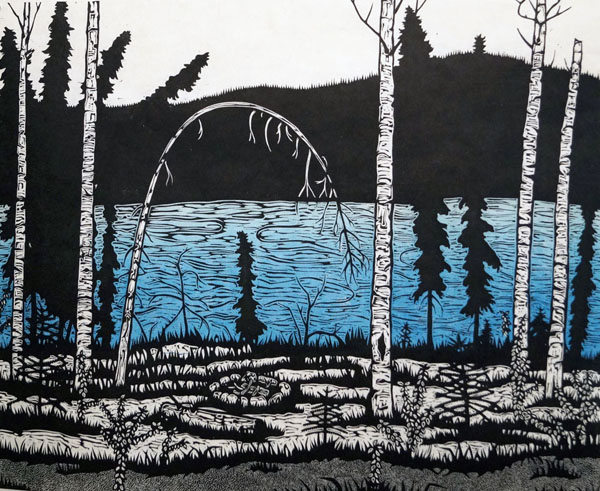
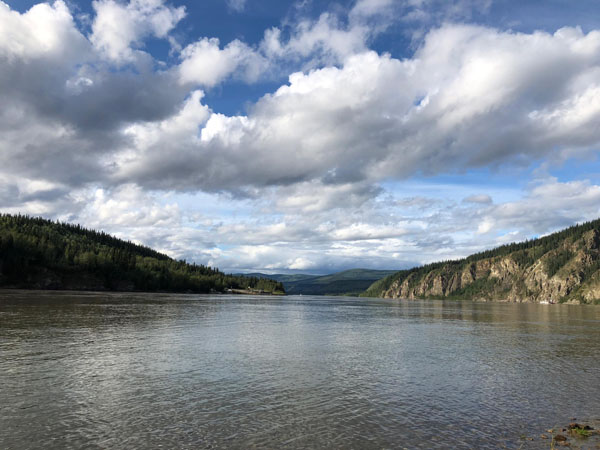
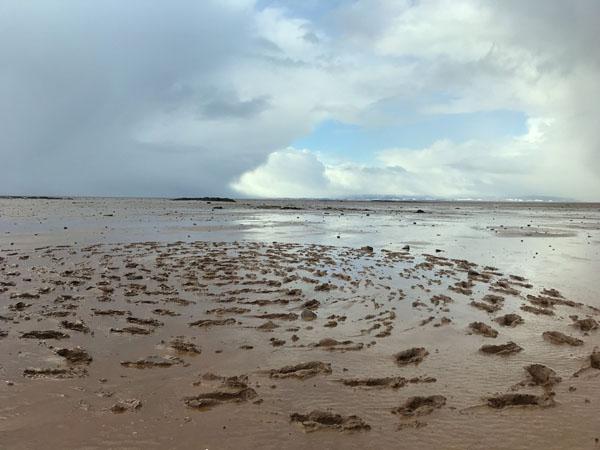
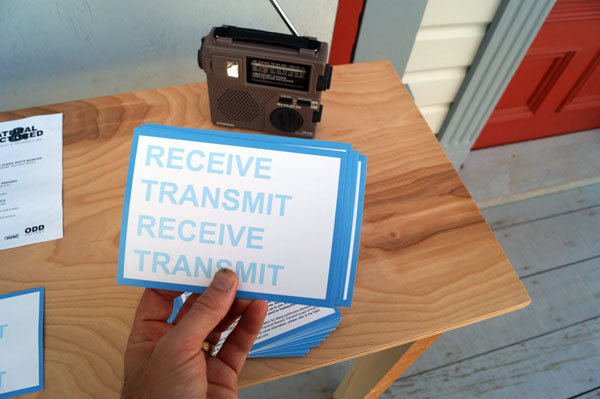
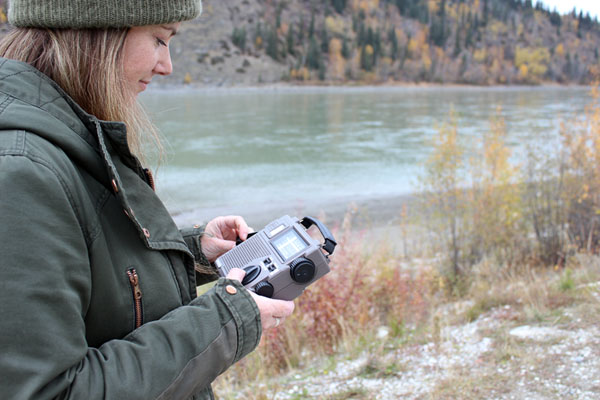
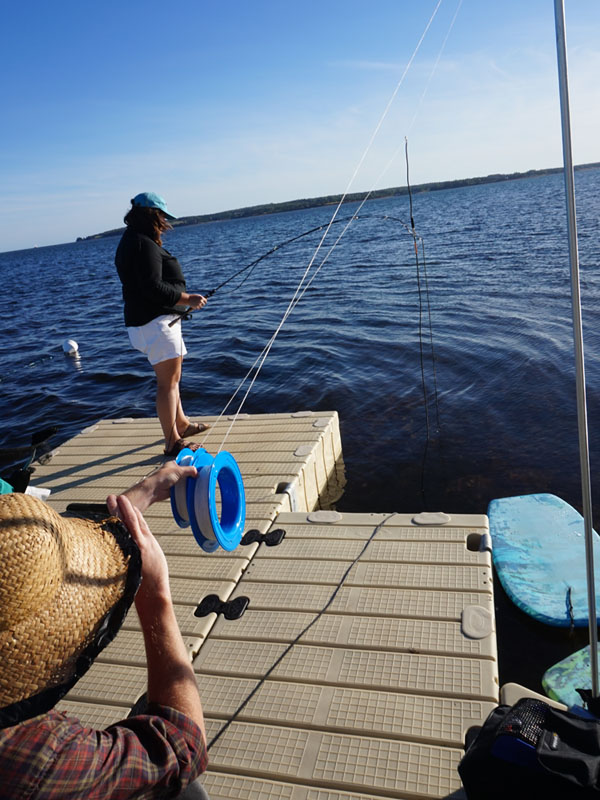
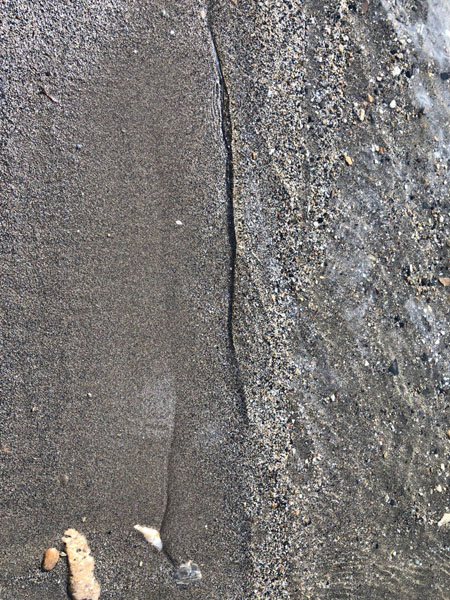
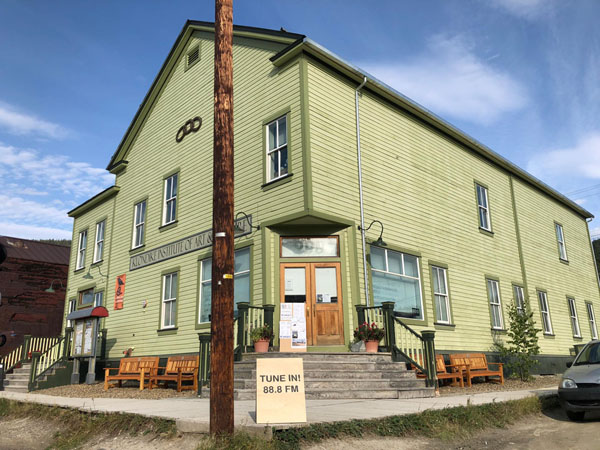
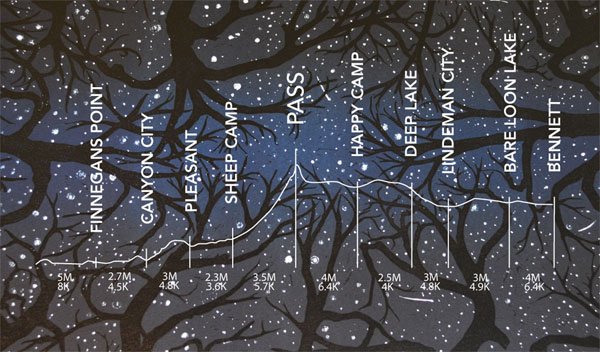
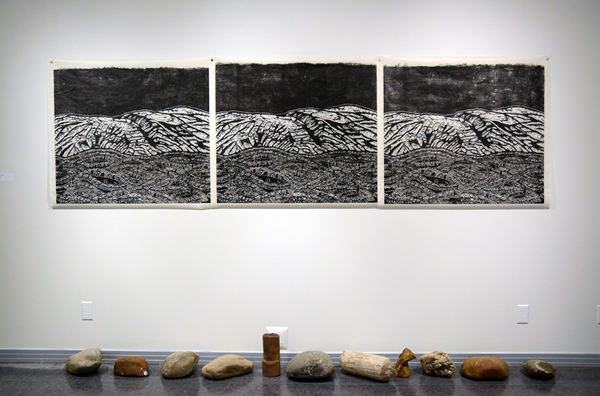 Klondike Tailings, woodcut on found wood, found objects, Josh Winkler, 2018. Photo: Janice Cliff
Klondike Tailings, woodcut on found wood, found objects, Josh Winkler, 2018. Photo: Janice Cliff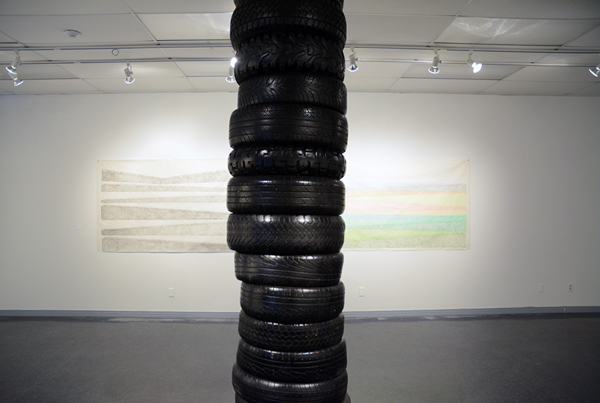
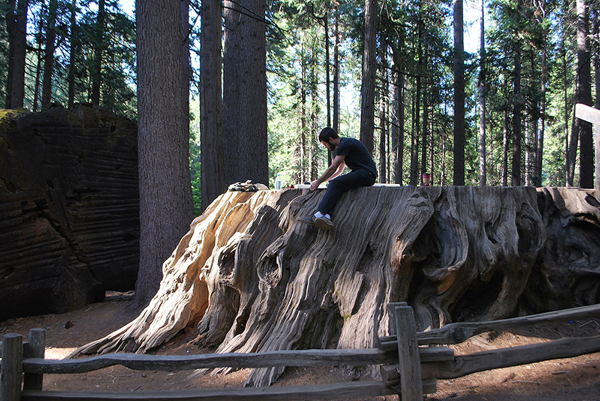
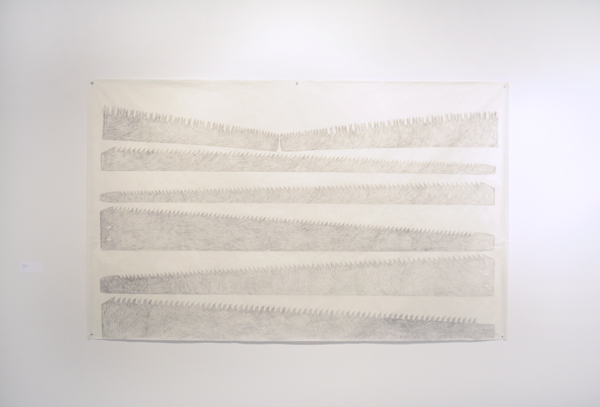
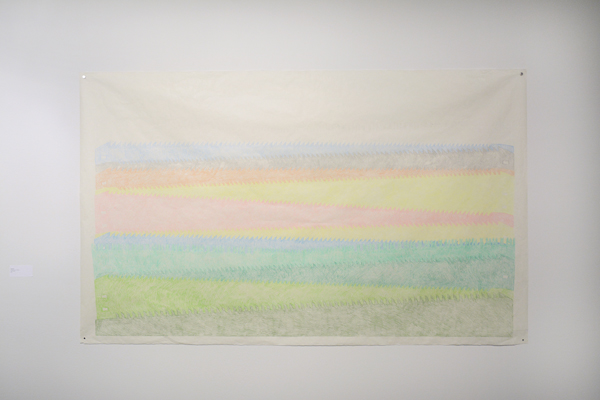
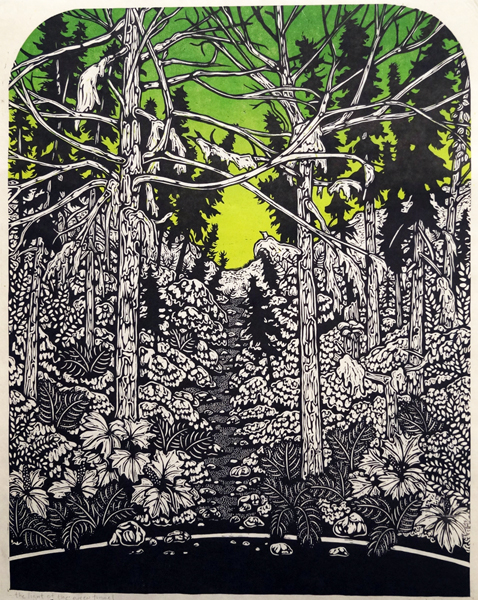

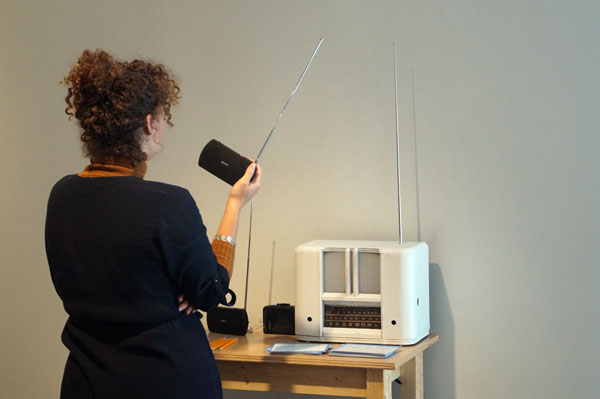
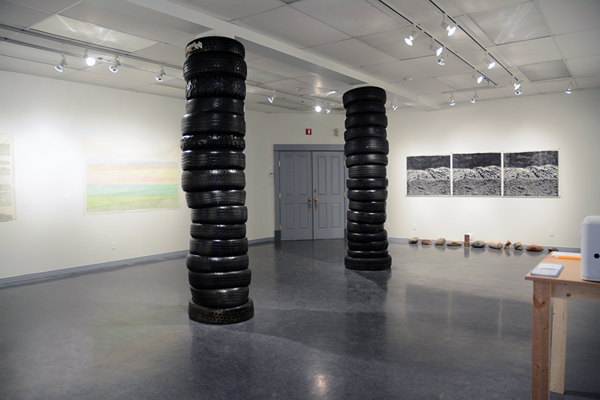
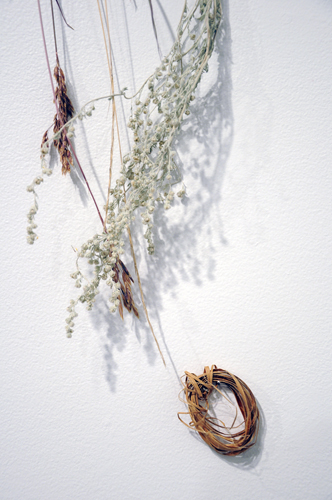
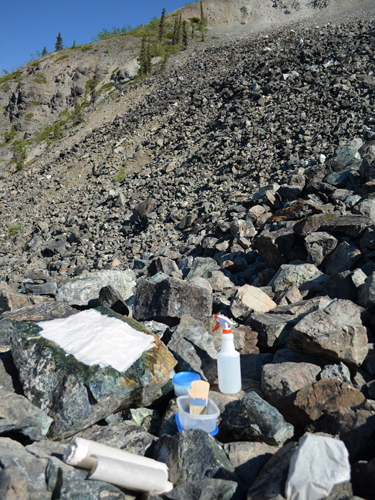
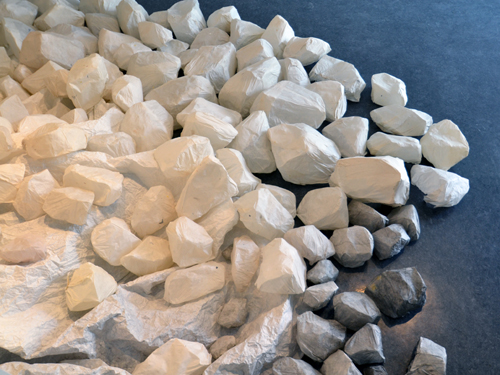
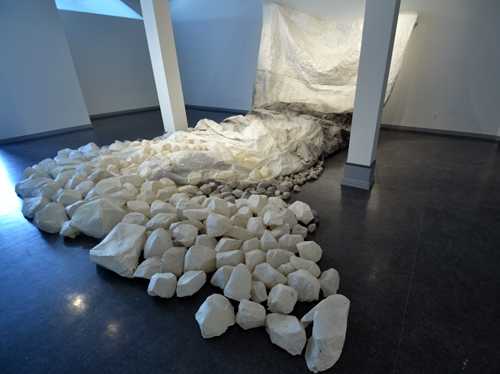
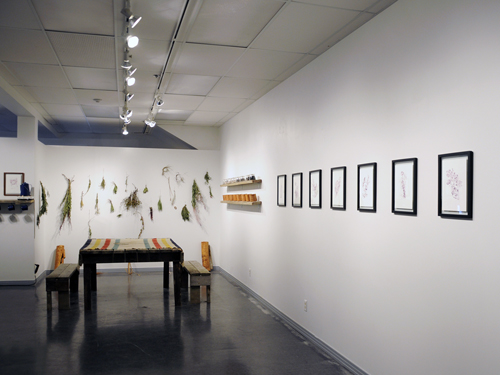
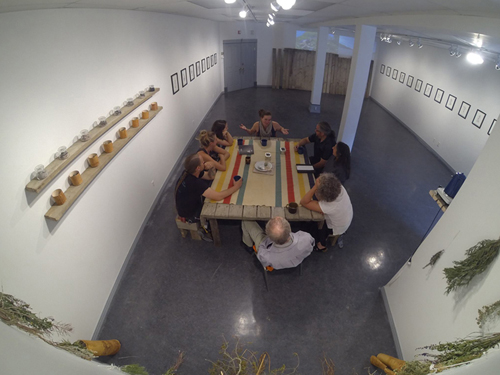
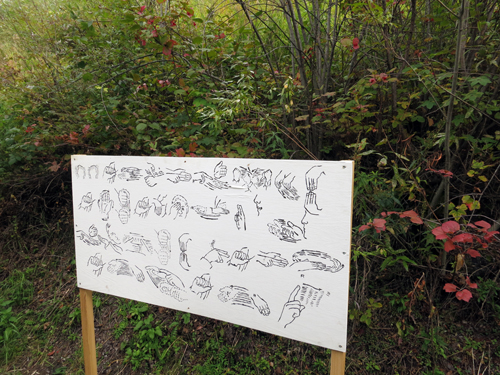
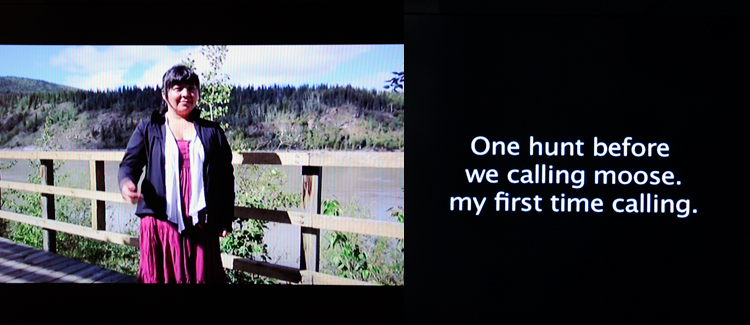
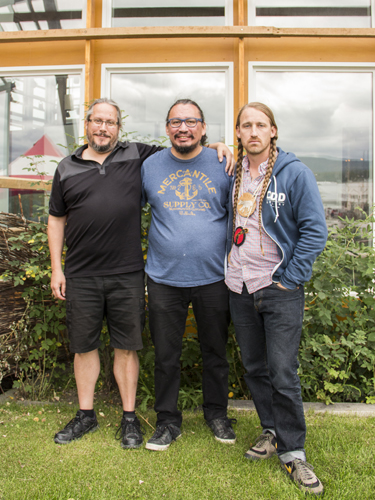
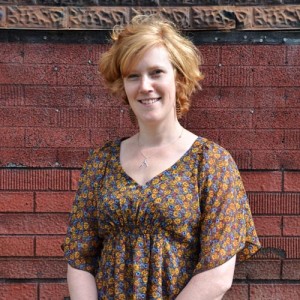 Sarah Fuller (July 5, 2013 – August 26, 2013)
Sarah Fuller (July 5, 2013 – August 26, 2013)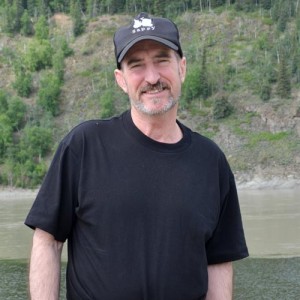 Paul Griffin (July 7, 2013 – August 19,2013)
Paul Griffin (July 7, 2013 – August 19,2013)